Auditing as a process to inspect and examine the finas
VerifiedAdded on 2021/10/12
|18
|3743
|217
AI Summary
The second part of the report involves in the analysis of the inherent risk of material misstatements of Cochlear Limited at financial report level. Analytical Procedures Comparison of Income Statement and Balance Sheet for Last Three Years Particulars 2016 ($m) 2017 ($m) 2018 ($m) Change in % from 2016 to 2017 Change in % from 2017 to 2018 Revenue 1,130.6 1,253.8 1,363.7 10.9% 8.8% Cost of Sales 333.6 358.4 91.2 7.4% 0.8%
Contribute Materials
Your contribution can guide someone’s learning journey. Share your
documents today.
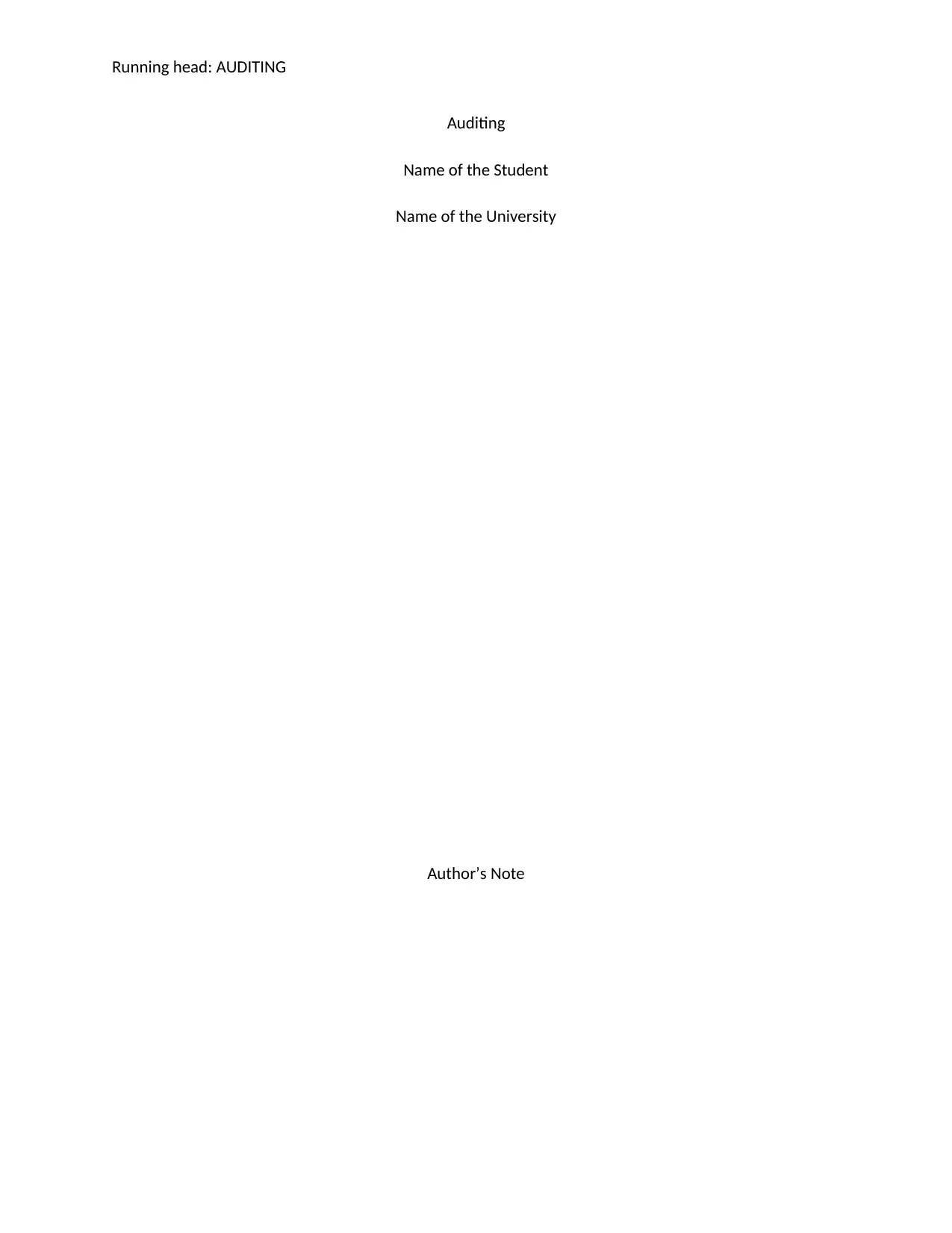
Running head: AUDITING
Auditing
Name of the Student
Name of the University
Author’s Note
Auditing
Name of the Student
Name of the University
Author’s Note
Secure Best Marks with AI Grader
Need help grading? Try our AI Grader for instant feedback on your assignments.
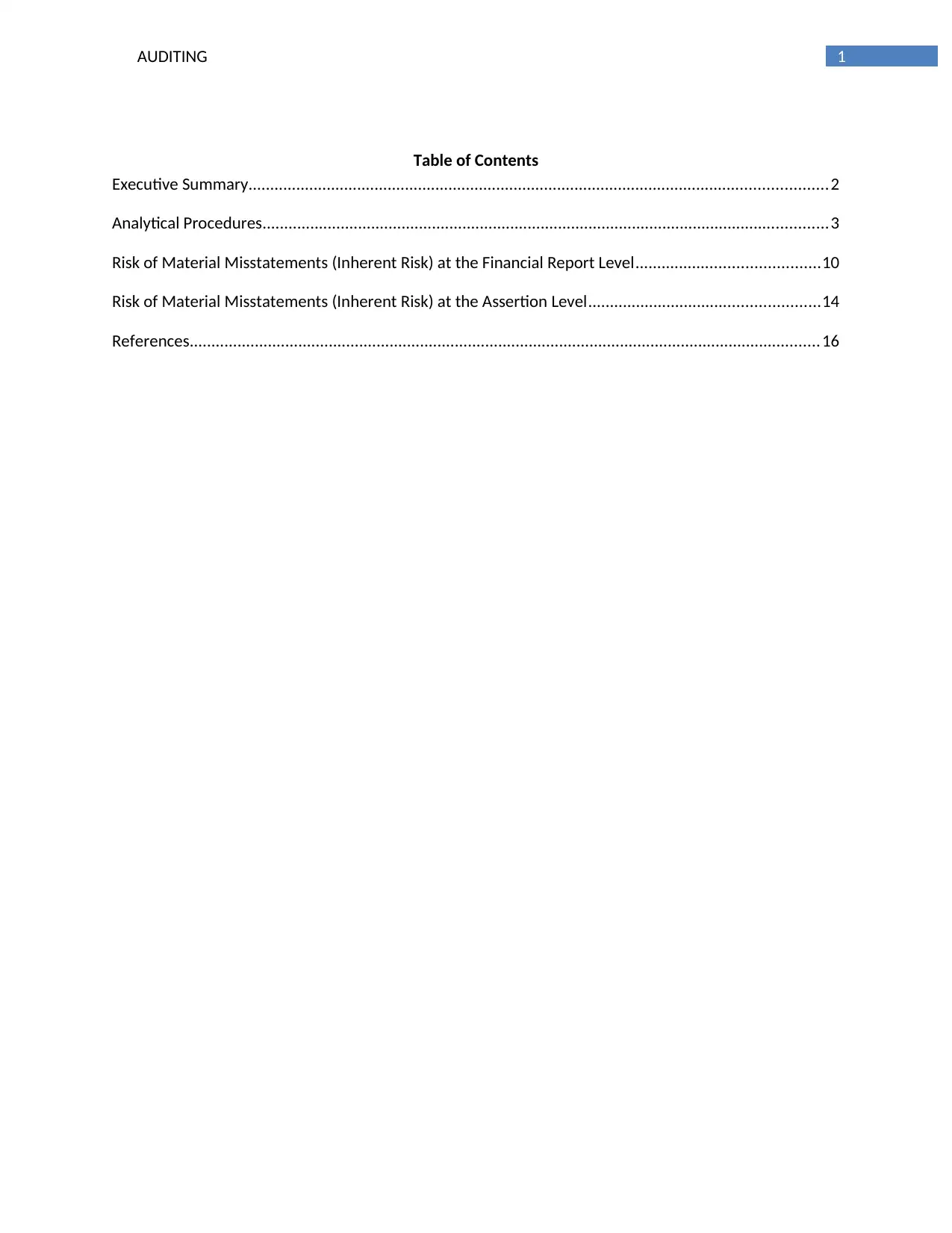
1AUDITING
Table of Contents
Executive Summary.....................................................................................................................................2
Analytical Procedures..................................................................................................................................3
Risk of Material Misstatements (Inherent Risk) at the Financial Report Level..........................................10
Risk of Material Misstatements (Inherent Risk) at the Assertion Level.....................................................14
References.................................................................................................................................................16
Table of Contents
Executive Summary.....................................................................................................................................2
Analytical Procedures..................................................................................................................................3
Risk of Material Misstatements (Inherent Risk) at the Financial Report Level..........................................10
Risk of Material Misstatements (Inherent Risk) at the Assertion Level.....................................................14
References.................................................................................................................................................16
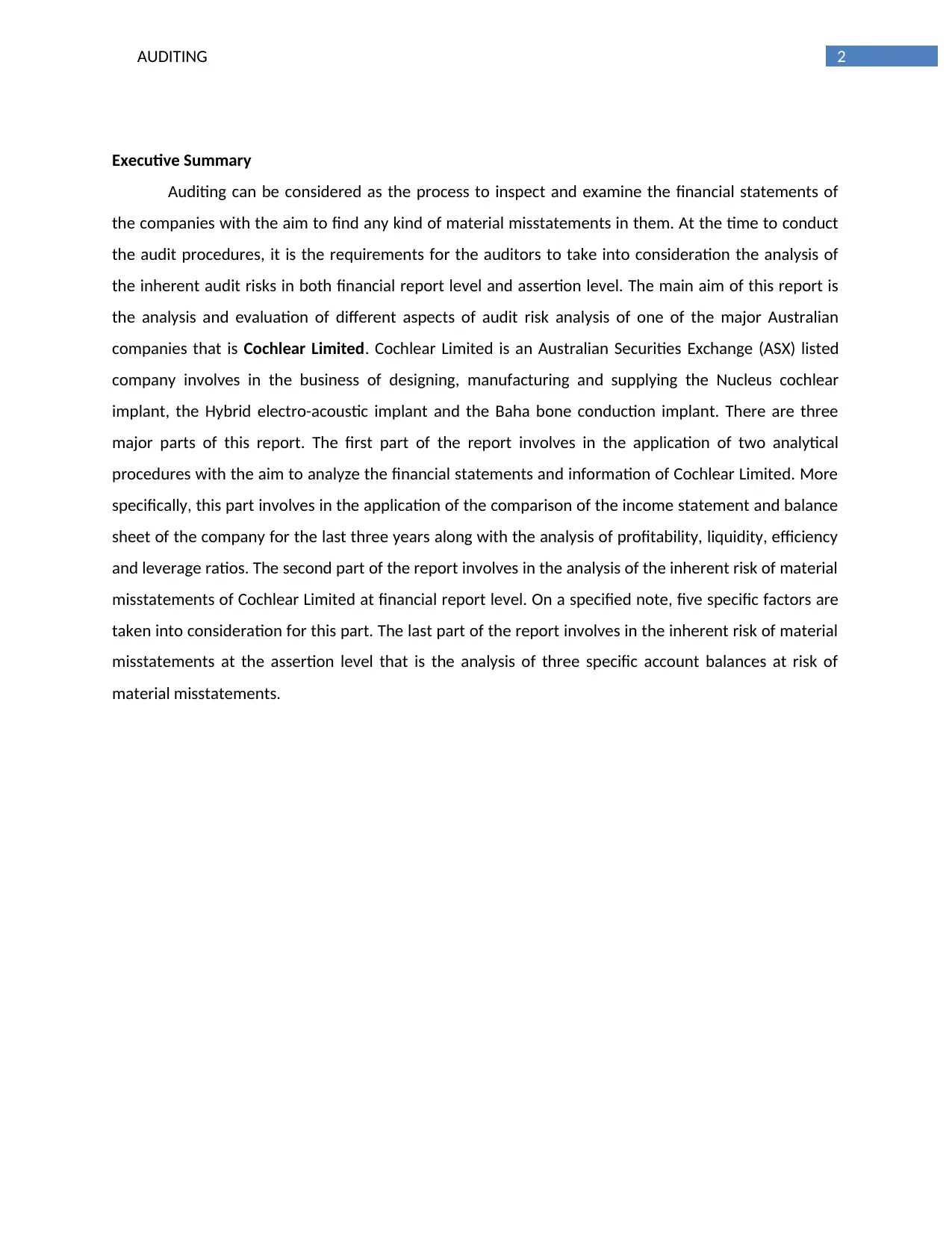
2AUDITING
Executive Summary
Auditing can be considered as the process to inspect and examine the financial statements of
the companies with the aim to find any kind of material misstatements in them. At the time to conduct
the audit procedures, it is the requirements for the auditors to take into consideration the analysis of
the inherent audit risks in both financial report level and assertion level. The main aim of this report is
the analysis and evaluation of different aspects of audit risk analysis of one of the major Australian
companies that is Cochlear Limited. Cochlear Limited is an Australian Securities Exchange (ASX) listed
company involves in the business of designing, manufacturing and supplying the Nucleus cochlear
implant, the Hybrid electro-acoustic implant and the Baha bone conduction implant. There are three
major parts of this report. The first part of the report involves in the application of two analytical
procedures with the aim to analyze the financial statements and information of Cochlear Limited. More
specifically, this part involves in the application of the comparison of the income statement and balance
sheet of the company for the last three years along with the analysis of profitability, liquidity, efficiency
and leverage ratios. The second part of the report involves in the analysis of the inherent risk of material
misstatements of Cochlear Limited at financial report level. On a specified note, five specific factors are
taken into consideration for this part. The last part of the report involves in the inherent risk of material
misstatements at the assertion level that is the analysis of three specific account balances at risk of
material misstatements.
Executive Summary
Auditing can be considered as the process to inspect and examine the financial statements of
the companies with the aim to find any kind of material misstatements in them. At the time to conduct
the audit procedures, it is the requirements for the auditors to take into consideration the analysis of
the inherent audit risks in both financial report level and assertion level. The main aim of this report is
the analysis and evaluation of different aspects of audit risk analysis of one of the major Australian
companies that is Cochlear Limited. Cochlear Limited is an Australian Securities Exchange (ASX) listed
company involves in the business of designing, manufacturing and supplying the Nucleus cochlear
implant, the Hybrid electro-acoustic implant and the Baha bone conduction implant. There are three
major parts of this report. The first part of the report involves in the application of two analytical
procedures with the aim to analyze the financial statements and information of Cochlear Limited. More
specifically, this part involves in the application of the comparison of the income statement and balance
sheet of the company for the last three years along with the analysis of profitability, liquidity, efficiency
and leverage ratios. The second part of the report involves in the analysis of the inherent risk of material
misstatements of Cochlear Limited at financial report level. On a specified note, five specific factors are
taken into consideration for this part. The last part of the report involves in the inherent risk of material
misstatements at the assertion level that is the analysis of three specific account balances at risk of
material misstatements.
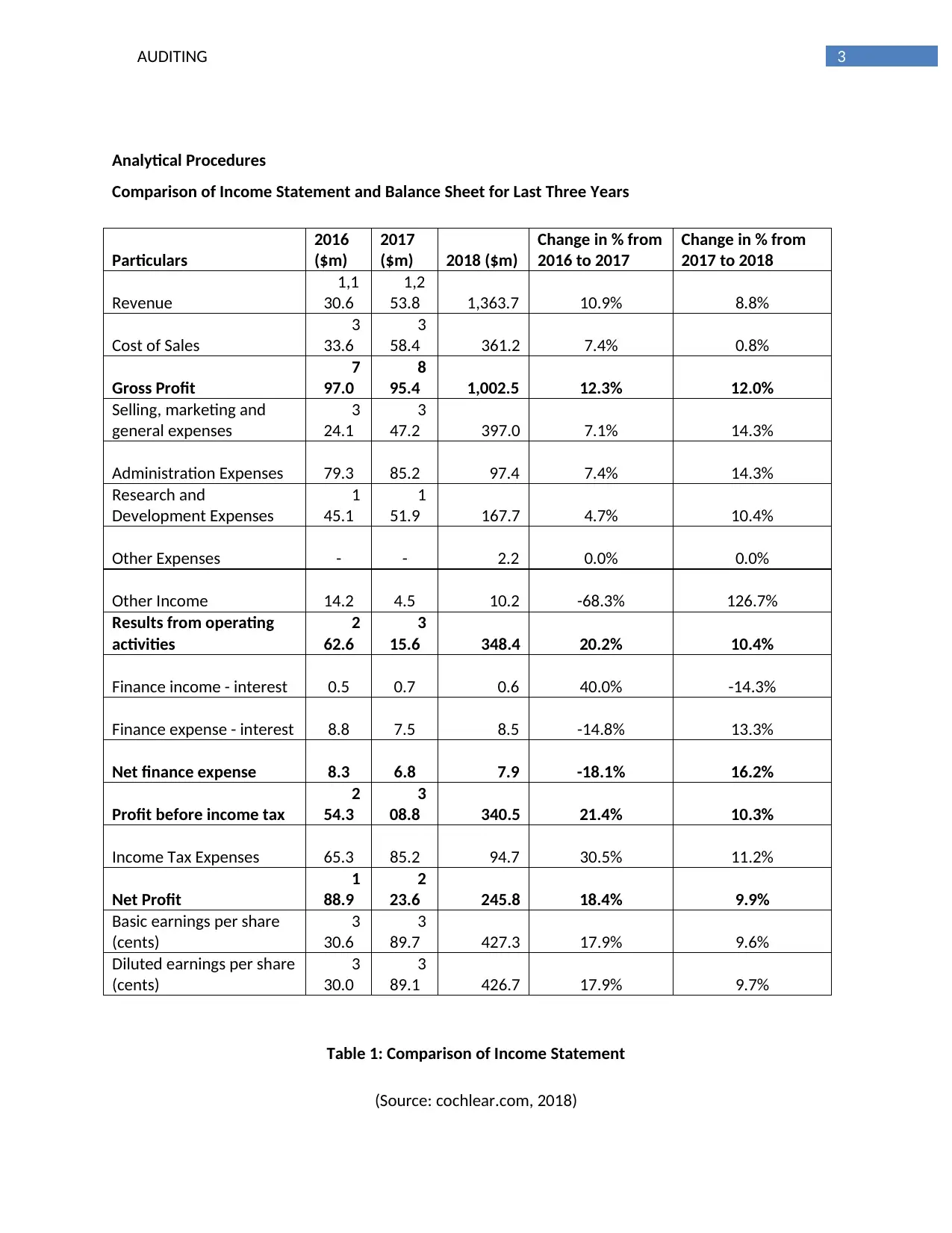
3AUDITING
Analytical Procedures
Comparison of Income Statement and Balance Sheet for Last Three Years
Particulars
2016
($m)
2017
($m) 2018 ($m)
Change in % from
2016 to 2017
Change in % from
2017 to 2018
Revenue
1,1
30.6
1,2
53.8 1,363.7 10.9% 8.8%
Cost of Sales
3
33.6
3
58.4 361.2 7.4% 0.8%
Gross Profit
7
97.0
8
95.4 1,002.5 12.3% 12.0%
Selling, marketing and
general expenses
3
24.1
3
47.2 397.0 7.1% 14.3%
Administration Expenses 79.3 85.2 97.4 7.4% 14.3%
Research and
Development Expenses
1
45.1
1
51.9 167.7 4.7% 10.4%
Other Expenses - - 2.2 0.0% 0.0%
Other Income 14.2 4.5 10.2 -68.3% 126.7%
Results from operating
activities
2
62.6
3
15.6 348.4 20.2% 10.4%
Finance income - interest 0.5 0.7 0.6 40.0% -14.3%
Finance expense - interest 8.8 7.5 8.5 -14.8% 13.3%
Net finance expense 8.3 6.8 7.9 -18.1% 16.2%
Profit before income tax
2
54.3
3
08.8 340.5 21.4% 10.3%
Income Tax Expenses 65.3 85.2 94.7 30.5% 11.2%
Net Profit
1
88.9
2
23.6 245.8 18.4% 9.9%
Basic earnings per share
(cents)
3
30.6
3
89.7 427.3 17.9% 9.6%
Diluted earnings per share
(cents)
3
30.0
3
89.1 426.7 17.9% 9.7%
Table 1: Comparison of Income Statement
(Source: cochlear.com, 2018)
Analytical Procedures
Comparison of Income Statement and Balance Sheet for Last Three Years
Particulars
2016
($m)
2017
($m) 2018 ($m)
Change in % from
2016 to 2017
Change in % from
2017 to 2018
Revenue
1,1
30.6
1,2
53.8 1,363.7 10.9% 8.8%
Cost of Sales
3
33.6
3
58.4 361.2 7.4% 0.8%
Gross Profit
7
97.0
8
95.4 1,002.5 12.3% 12.0%
Selling, marketing and
general expenses
3
24.1
3
47.2 397.0 7.1% 14.3%
Administration Expenses 79.3 85.2 97.4 7.4% 14.3%
Research and
Development Expenses
1
45.1
1
51.9 167.7 4.7% 10.4%
Other Expenses - - 2.2 0.0% 0.0%
Other Income 14.2 4.5 10.2 -68.3% 126.7%
Results from operating
activities
2
62.6
3
15.6 348.4 20.2% 10.4%
Finance income - interest 0.5 0.7 0.6 40.0% -14.3%
Finance expense - interest 8.8 7.5 8.5 -14.8% 13.3%
Net finance expense 8.3 6.8 7.9 -18.1% 16.2%
Profit before income tax
2
54.3
3
08.8 340.5 21.4% 10.3%
Income Tax Expenses 65.3 85.2 94.7 30.5% 11.2%
Net Profit
1
88.9
2
23.6 245.8 18.4% 9.9%
Basic earnings per share
(cents)
3
30.6
3
89.7 427.3 17.9% 9.6%
Diluted earnings per share
(cents)
3
30.0
3
89.1 426.7 17.9% 9.7%
Table 1: Comparison of Income Statement
(Source: cochlear.com, 2018)
Secure Best Marks with AI Grader
Need help grading? Try our AI Grader for instant feedback on your assignments.
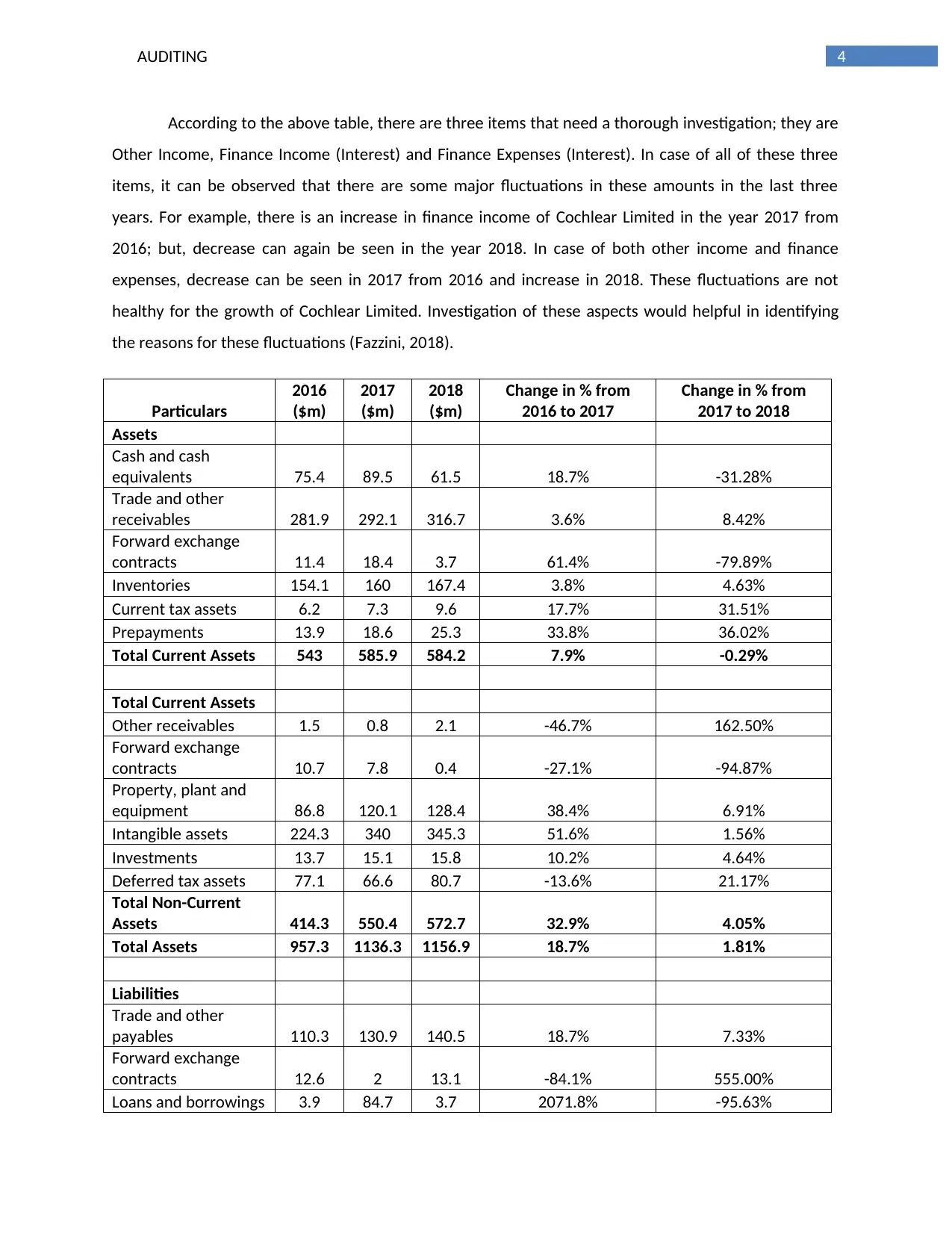
4AUDITING
According to the above table, there are three items that need a thorough investigation; they are
Other Income, Finance Income (Interest) and Finance Expenses (Interest). In case of all of these three
items, it can be observed that there are some major fluctuations in these amounts in the last three
years. For example, there is an increase in finance income of Cochlear Limited in the year 2017 from
2016; but, decrease can again be seen in the year 2018. In case of both other income and finance
expenses, decrease can be seen in 2017 from 2016 and increase in 2018. These fluctuations are not
healthy for the growth of Cochlear Limited. Investigation of these aspects would helpful in identifying
the reasons for these fluctuations (Fazzini, 2018).
Particulars
2016
($m)
2017
($m)
2018
($m)
Change in % from
2016 to 2017
Change in % from
2017 to 2018
Assets
Cash and cash
equivalents 75.4 89.5 61.5 18.7% -31.28%
Trade and other
receivables 281.9 292.1 316.7 3.6% 8.42%
Forward exchange
contracts 11.4 18.4 3.7 61.4% -79.89%
Inventories 154.1 160 167.4 3.8% 4.63%
Current tax assets 6.2 7.3 9.6 17.7% 31.51%
Prepayments 13.9 18.6 25.3 33.8% 36.02%
Total Current Assets 543 585.9 584.2 7.9% -0.29%
Total Current Assets
Other receivables 1.5 0.8 2.1 -46.7% 162.50%
Forward exchange
contracts 10.7 7.8 0.4 -27.1% -94.87%
Property, plant and
equipment 86.8 120.1 128.4 38.4% 6.91%
Intangible assets 224.3 340 345.3 51.6% 1.56%
Investments 13.7 15.1 15.8 10.2% 4.64%
Deferred tax assets 77.1 66.6 80.7 -13.6% 21.17%
Total Non-Current
Assets 414.3 550.4 572.7 32.9% 4.05%
Total Assets 957.3 1136.3 1156.9 18.7% 1.81%
Liabilities
Trade and other
payables 110.3 130.9 140.5 18.7% 7.33%
Forward exchange
contracts 12.6 2 13.1 -84.1% 555.00%
Loans and borrowings 3.9 84.7 3.7 2071.8% -95.63%
According to the above table, there are three items that need a thorough investigation; they are
Other Income, Finance Income (Interest) and Finance Expenses (Interest). In case of all of these three
items, it can be observed that there are some major fluctuations in these amounts in the last three
years. For example, there is an increase in finance income of Cochlear Limited in the year 2017 from
2016; but, decrease can again be seen in the year 2018. In case of both other income and finance
expenses, decrease can be seen in 2017 from 2016 and increase in 2018. These fluctuations are not
healthy for the growth of Cochlear Limited. Investigation of these aspects would helpful in identifying
the reasons for these fluctuations (Fazzini, 2018).
Particulars
2016
($m)
2017
($m)
2018
($m)
Change in % from
2016 to 2017
Change in % from
2017 to 2018
Assets
Cash and cash
equivalents 75.4 89.5 61.5 18.7% -31.28%
Trade and other
receivables 281.9 292.1 316.7 3.6% 8.42%
Forward exchange
contracts 11.4 18.4 3.7 61.4% -79.89%
Inventories 154.1 160 167.4 3.8% 4.63%
Current tax assets 6.2 7.3 9.6 17.7% 31.51%
Prepayments 13.9 18.6 25.3 33.8% 36.02%
Total Current Assets 543 585.9 584.2 7.9% -0.29%
Total Current Assets
Other receivables 1.5 0.8 2.1 -46.7% 162.50%
Forward exchange
contracts 10.7 7.8 0.4 -27.1% -94.87%
Property, plant and
equipment 86.8 120.1 128.4 38.4% 6.91%
Intangible assets 224.3 340 345.3 51.6% 1.56%
Investments 13.7 15.1 15.8 10.2% 4.64%
Deferred tax assets 77.1 66.6 80.7 -13.6% 21.17%
Total Non-Current
Assets 414.3 550.4 572.7 32.9% 4.05%
Total Assets 957.3 1136.3 1156.9 18.7% 1.81%
Liabilities
Trade and other
payables 110.3 130.9 140.5 18.7% 7.33%
Forward exchange
contracts 12.6 2 13.1 -84.1% 555.00%
Loans and borrowings 3.9 84.7 3.7 2071.8% -95.63%
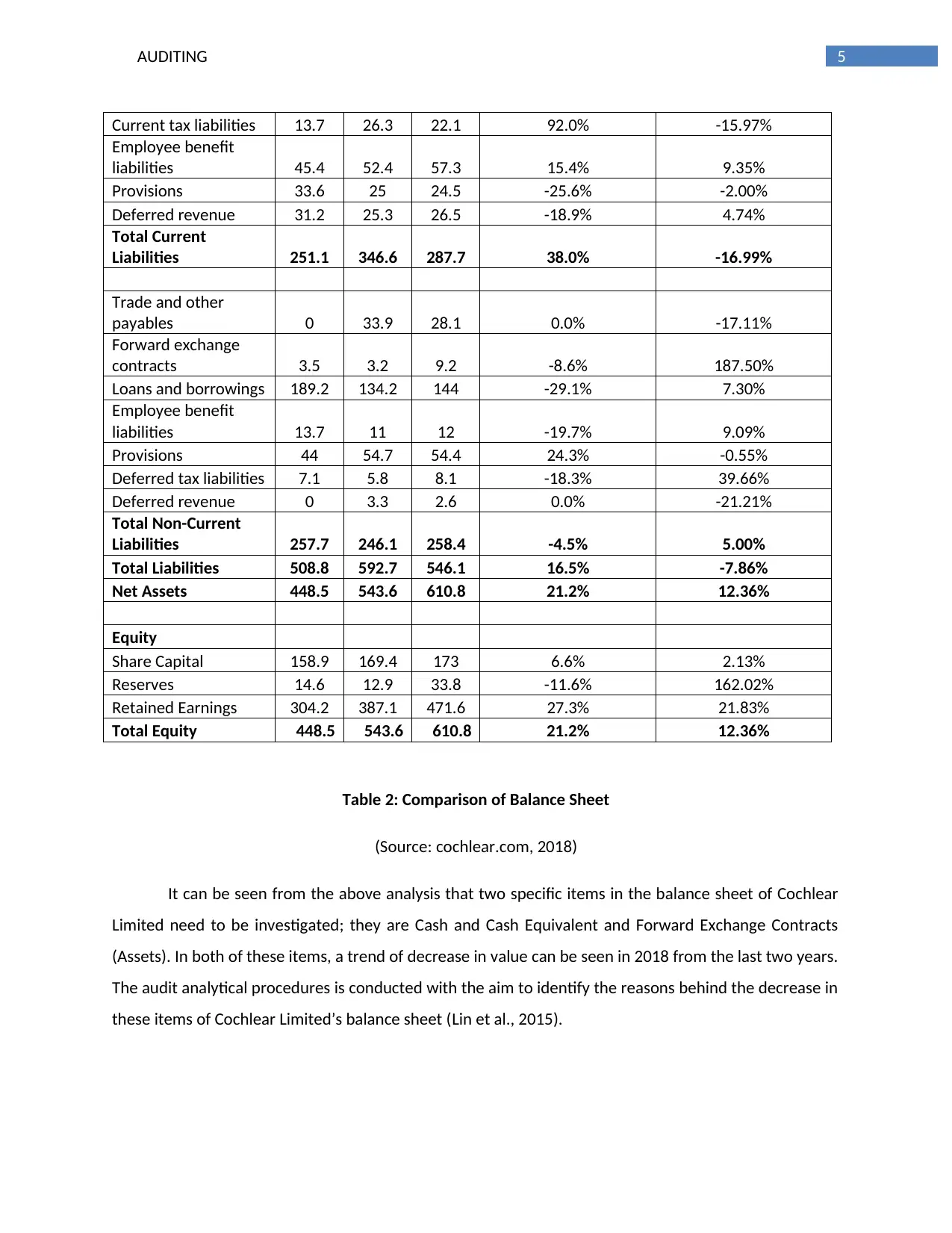
5AUDITING
Current tax liabilities 13.7 26.3 22.1 92.0% -15.97%
Employee benefit
liabilities 45.4 52.4 57.3 15.4% 9.35%
Provisions 33.6 25 24.5 -25.6% -2.00%
Deferred revenue 31.2 25.3 26.5 -18.9% 4.74%
Total Current
Liabilities 251.1 346.6 287.7 38.0% -16.99%
Trade and other
payables 0 33.9 28.1 0.0% -17.11%
Forward exchange
contracts 3.5 3.2 9.2 -8.6% 187.50%
Loans and borrowings 189.2 134.2 144 -29.1% 7.30%
Employee benefit
liabilities 13.7 11 12 -19.7% 9.09%
Provisions 44 54.7 54.4 24.3% -0.55%
Deferred tax liabilities 7.1 5.8 8.1 -18.3% 39.66%
Deferred revenue 0 3.3 2.6 0.0% -21.21%
Total Non-Current
Liabilities 257.7 246.1 258.4 -4.5% 5.00%
Total Liabilities 508.8 592.7 546.1 16.5% -7.86%
Net Assets 448.5 543.6 610.8 21.2% 12.36%
Equity
Share Capital 158.9 169.4 173 6.6% 2.13%
Reserves 14.6 12.9 33.8 -11.6% 162.02%
Retained Earnings 304.2 387.1 471.6 27.3% 21.83%
Total Equity 448.5 543.6 610.8 21.2% 12.36%
Table 2: Comparison of Balance Sheet
(Source: cochlear.com, 2018)
It can be seen from the above analysis that two specific items in the balance sheet of Cochlear
Limited need to be investigated; they are Cash and Cash Equivalent and Forward Exchange Contracts
(Assets). In both of these items, a trend of decrease in value can be seen in 2018 from the last two years.
The audit analytical procedures is conducted with the aim to identify the reasons behind the decrease in
these items of Cochlear Limited’s balance sheet (Lin et al., 2015).
Current tax liabilities 13.7 26.3 22.1 92.0% -15.97%
Employee benefit
liabilities 45.4 52.4 57.3 15.4% 9.35%
Provisions 33.6 25 24.5 -25.6% -2.00%
Deferred revenue 31.2 25.3 26.5 -18.9% 4.74%
Total Current
Liabilities 251.1 346.6 287.7 38.0% -16.99%
Trade and other
payables 0 33.9 28.1 0.0% -17.11%
Forward exchange
contracts 3.5 3.2 9.2 -8.6% 187.50%
Loans and borrowings 189.2 134.2 144 -29.1% 7.30%
Employee benefit
liabilities 13.7 11 12 -19.7% 9.09%
Provisions 44 54.7 54.4 24.3% -0.55%
Deferred tax liabilities 7.1 5.8 8.1 -18.3% 39.66%
Deferred revenue 0 3.3 2.6 0.0% -21.21%
Total Non-Current
Liabilities 257.7 246.1 258.4 -4.5% 5.00%
Total Liabilities 508.8 592.7 546.1 16.5% -7.86%
Net Assets 448.5 543.6 610.8 21.2% 12.36%
Equity
Share Capital 158.9 169.4 173 6.6% 2.13%
Reserves 14.6 12.9 33.8 -11.6% 162.02%
Retained Earnings 304.2 387.1 471.6 27.3% 21.83%
Total Equity 448.5 543.6 610.8 21.2% 12.36%
Table 2: Comparison of Balance Sheet
(Source: cochlear.com, 2018)
It can be seen from the above analysis that two specific items in the balance sheet of Cochlear
Limited need to be investigated; they are Cash and Cash Equivalent and Forward Exchange Contracts
(Assets). In both of these items, a trend of decrease in value can be seen in 2018 from the last two years.
The audit analytical procedures is conducted with the aim to identify the reasons behind the decrease in
these items of Cochlear Limited’s balance sheet (Lin et al., 2015).
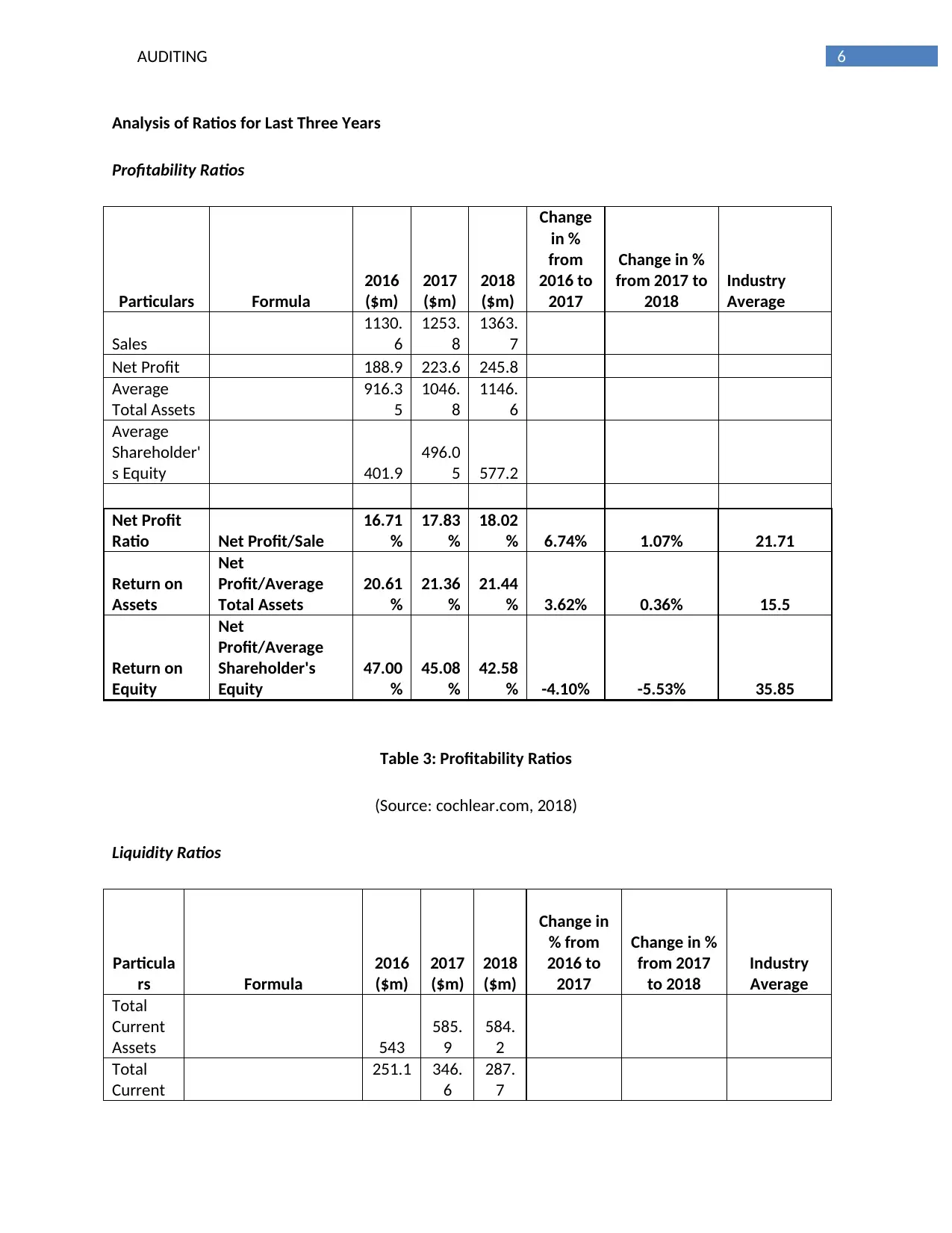
6AUDITING
Analysis of Ratios for Last Three Years
Profitability Ratios
Particulars Formula
2016
($m)
2017
($m)
2018
($m)
Change
in %
from
2016 to
2017
Change in %
from 2017 to
2018
Industry
Average
Sales
1130.
6
1253.
8
1363.
7
Net Profit 188.9 223.6 245.8
Average
Total Assets
916.3
5
1046.
8
1146.
6
Average
Shareholder'
s Equity 401.9
496.0
5 577.2
Net Profit
Ratio Net Profit/Sale
16.71
%
17.83
%
18.02
% 6.74% 1.07% 21.71
Return on
Assets
Net
Profit/Average
Total Assets
20.61
%
21.36
%
21.44
% 3.62% 0.36% 15.5
Return on
Equity
Net
Profit/Average
Shareholder's
Equity
47.00
%
45.08
%
42.58
% -4.10% -5.53% 35.85
Table 3: Profitability Ratios
(Source: cochlear.com, 2018)
Liquidity Ratios
Particula
rs Formula
2016
($m)
2017
($m)
2018
($m)
Change in
% from
2016 to
2017
Change in %
from 2017
to 2018
Industry
Average
Total
Current
Assets 543
585.
9
584.
2
Total
Current
251.1 346.
6
287.
7
Analysis of Ratios for Last Three Years
Profitability Ratios
Particulars Formula
2016
($m)
2017
($m)
2018
($m)
Change
in %
from
2016 to
2017
Change in %
from 2017 to
2018
Industry
Average
Sales
1130.
6
1253.
8
1363.
7
Net Profit 188.9 223.6 245.8
Average
Total Assets
916.3
5
1046.
8
1146.
6
Average
Shareholder'
s Equity 401.9
496.0
5 577.2
Net Profit
Ratio Net Profit/Sale
16.71
%
17.83
%
18.02
% 6.74% 1.07% 21.71
Return on
Assets
Net
Profit/Average
Total Assets
20.61
%
21.36
%
21.44
% 3.62% 0.36% 15.5
Return on
Equity
Net
Profit/Average
Shareholder's
Equity
47.00
%
45.08
%
42.58
% -4.10% -5.53% 35.85
Table 3: Profitability Ratios
(Source: cochlear.com, 2018)
Liquidity Ratios
Particula
rs Formula
2016
($m)
2017
($m)
2018
($m)
Change in
% from
2016 to
2017
Change in %
from 2017
to 2018
Industry
Average
Total
Current
Assets 543
585.
9
584.
2
Total
Current
251.1 346.
6
287.
7
Paraphrase This Document
Need a fresh take? Get an instant paraphrase of this document with our AI Paraphraser
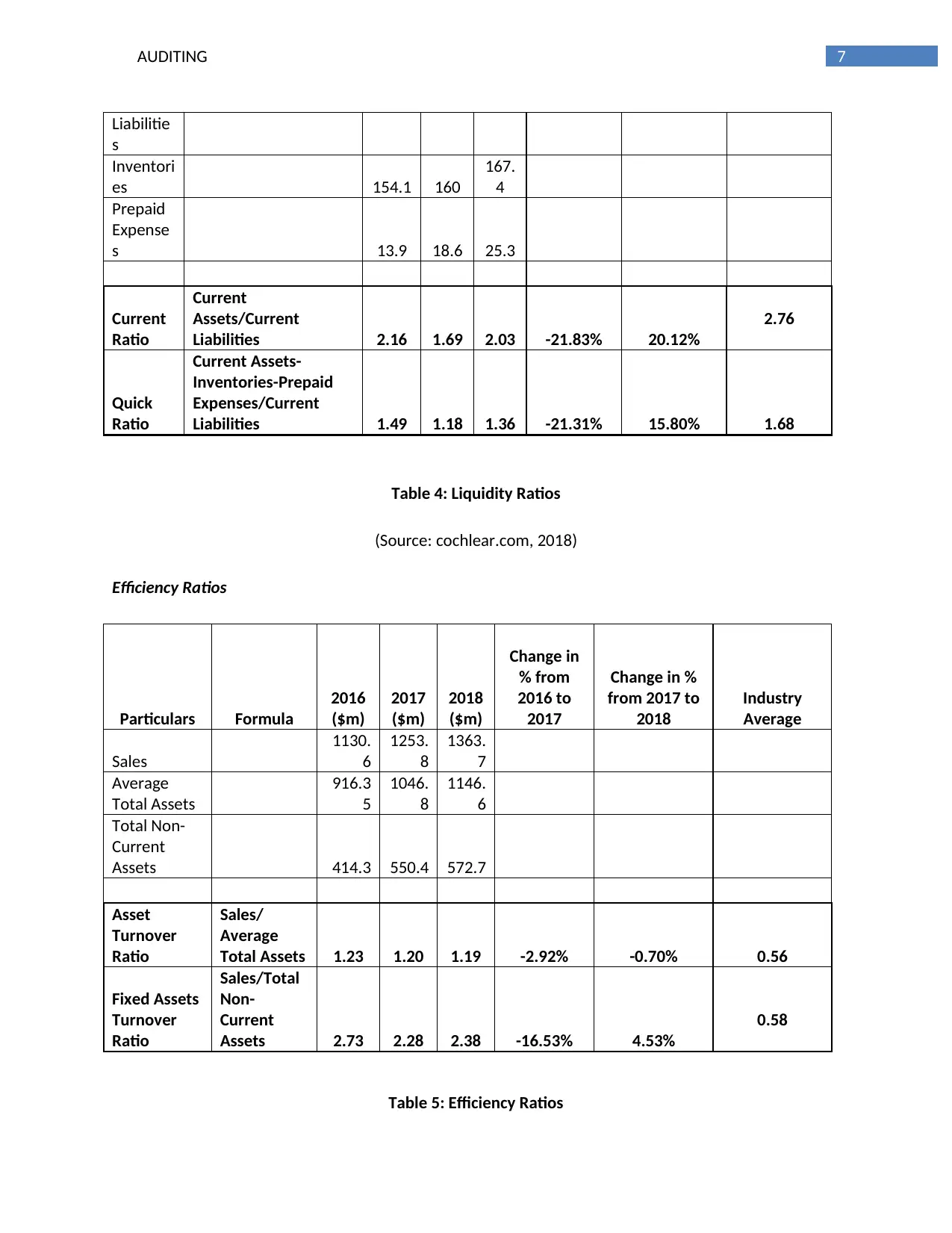
7AUDITING
Liabilitie
s
Inventori
es 154.1 160
167.
4
Prepaid
Expense
s 13.9 18.6 25.3
Current
Ratio
Current
Assets/Current
Liabilities 2.16 1.69 2.03 -21.83% 20.12%
2.76
Quick
Ratio
Current Assets-
Inventories-Prepaid
Expenses/Current
Liabilities 1.49 1.18 1.36 -21.31% 15.80% 1.68
Table 4: Liquidity Ratios
(Source: cochlear.com, 2018)
Efficiency Ratios
Particulars Formula
2016
($m)
2017
($m)
2018
($m)
Change in
% from
2016 to
2017
Change in %
from 2017 to
2018
Industry
Average
Sales
1130.
6
1253.
8
1363.
7
Average
Total Assets
916.3
5
1046.
8
1146.
6
Total Non-
Current
Assets 414.3 550.4 572.7
Asset
Turnover
Ratio
Sales/
Average
Total Assets 1.23 1.20 1.19 -2.92% -0.70% 0.56
Fixed Assets
Turnover
Ratio
Sales/Total
Non-
Current
Assets 2.73 2.28 2.38 -16.53% 4.53%
0.58
Table 5: Efficiency Ratios
Liabilitie
s
Inventori
es 154.1 160
167.
4
Prepaid
Expense
s 13.9 18.6 25.3
Current
Ratio
Current
Assets/Current
Liabilities 2.16 1.69 2.03 -21.83% 20.12%
2.76
Quick
Ratio
Current Assets-
Inventories-Prepaid
Expenses/Current
Liabilities 1.49 1.18 1.36 -21.31% 15.80% 1.68
Table 4: Liquidity Ratios
(Source: cochlear.com, 2018)
Efficiency Ratios
Particulars Formula
2016
($m)
2017
($m)
2018
($m)
Change in
% from
2016 to
2017
Change in %
from 2017 to
2018
Industry
Average
Sales
1130.
6
1253.
8
1363.
7
Average
Total Assets
916.3
5
1046.
8
1146.
6
Total Non-
Current
Assets 414.3 550.4 572.7
Asset
Turnover
Ratio
Sales/
Average
Total Assets 1.23 1.20 1.19 -2.92% -0.70% 0.56
Fixed Assets
Turnover
Ratio
Sales/Total
Non-
Current
Assets 2.73 2.28 2.38 -16.53% 4.53%
0.58
Table 5: Efficiency Ratios
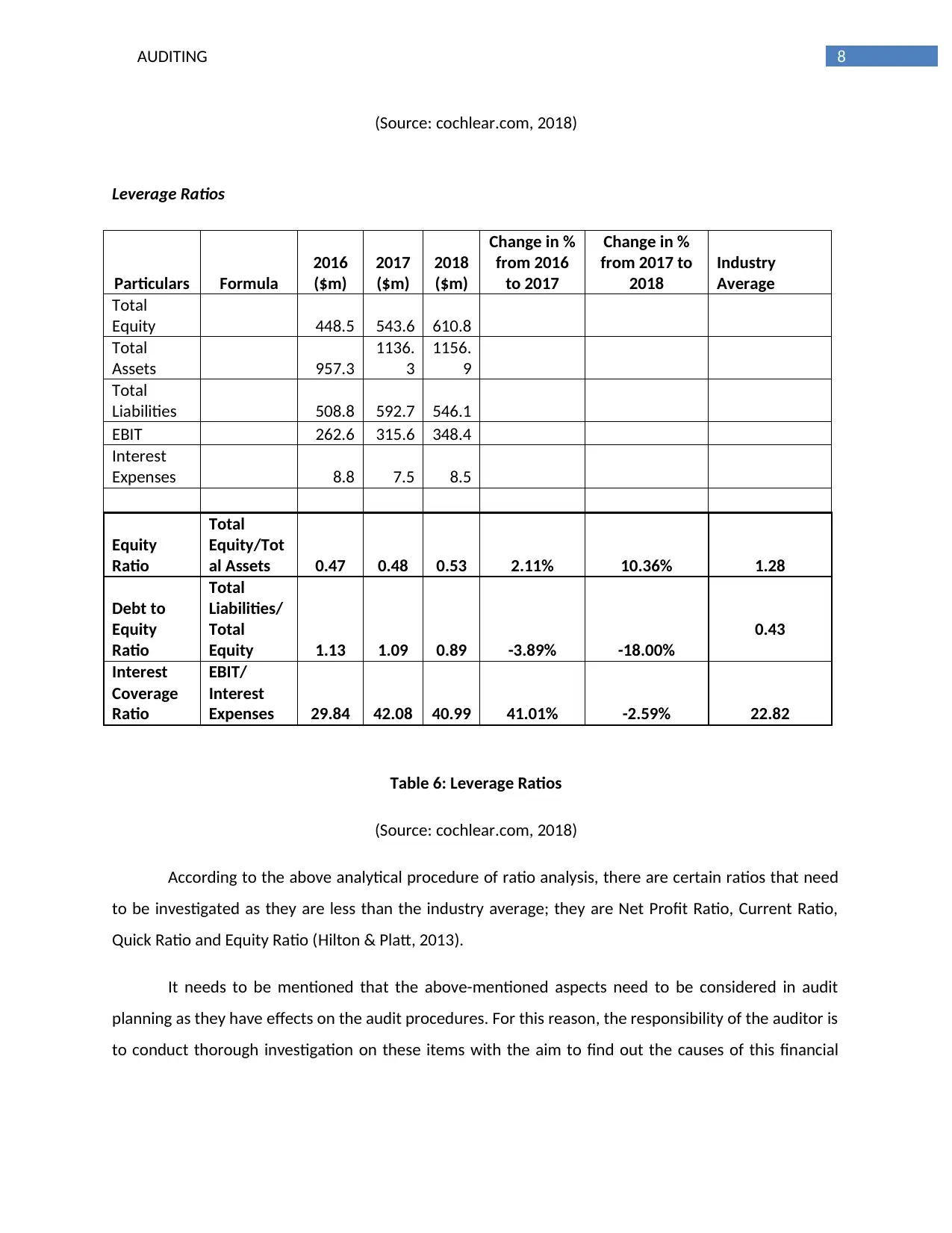
8AUDITING
(Source: cochlear.com, 2018)
Leverage Ratios
Particulars Formula
2016
($m)
2017
($m)
2018
($m)
Change in %
from 2016
to 2017
Change in %
from 2017 to
2018
Industry
Average
Total
Equity 448.5 543.6 610.8
Total
Assets 957.3
1136.
3
1156.
9
Total
Liabilities 508.8 592.7 546.1
EBIT 262.6 315.6 348.4
Interest
Expenses 8.8 7.5 8.5
Equity
Ratio
Total
Equity/Tot
al Assets 0.47 0.48 0.53 2.11% 10.36% 1.28
Debt to
Equity
Ratio
Total
Liabilities/
Total
Equity 1.13 1.09 0.89 -3.89% -18.00%
0.43
Interest
Coverage
Ratio
EBIT/
Interest
Expenses 29.84 42.08 40.99 41.01% -2.59% 22.82
Table 6: Leverage Ratios
(Source: cochlear.com, 2018)
According to the above analytical procedure of ratio analysis, there are certain ratios that need
to be investigated as they are less than the industry average; they are Net Profit Ratio, Current Ratio,
Quick Ratio and Equity Ratio (Hilton & Platt, 2013).
It needs to be mentioned that the above-mentioned aspects need to be considered in audit
planning as they have effects on the audit procedures. For this reason, the responsibility of the auditor is
to conduct thorough investigation on these items with the aim to find out the causes of this financial
(Source: cochlear.com, 2018)
Leverage Ratios
Particulars Formula
2016
($m)
2017
($m)
2018
($m)
Change in %
from 2016
to 2017
Change in %
from 2017 to
2018
Industry
Average
Total
Equity 448.5 543.6 610.8
Total
Assets 957.3
1136.
3
1156.
9
Total
Liabilities 508.8 592.7 546.1
EBIT 262.6 315.6 348.4
Interest
Expenses 8.8 7.5 8.5
Equity
Ratio
Total
Equity/Tot
al Assets 0.47 0.48 0.53 2.11% 10.36% 1.28
Debt to
Equity
Ratio
Total
Liabilities/
Total
Equity 1.13 1.09 0.89 -3.89% -18.00%
0.43
Interest
Coverage
Ratio
EBIT/
Interest
Expenses 29.84 42.08 40.99 41.01% -2.59% 22.82
Table 6: Leverage Ratios
(Source: cochlear.com, 2018)
According to the above analytical procedure of ratio analysis, there are certain ratios that need
to be investigated as they are less than the industry average; they are Net Profit Ratio, Current Ratio,
Quick Ratio and Equity Ratio (Hilton & Platt, 2013).
It needs to be mentioned that the above-mentioned aspects need to be considered in audit
planning as they have effects on the audit procedures. For this reason, the responsibility of the auditor is
to conduct thorough investigation on these items with the aim to find out the causes of this financial
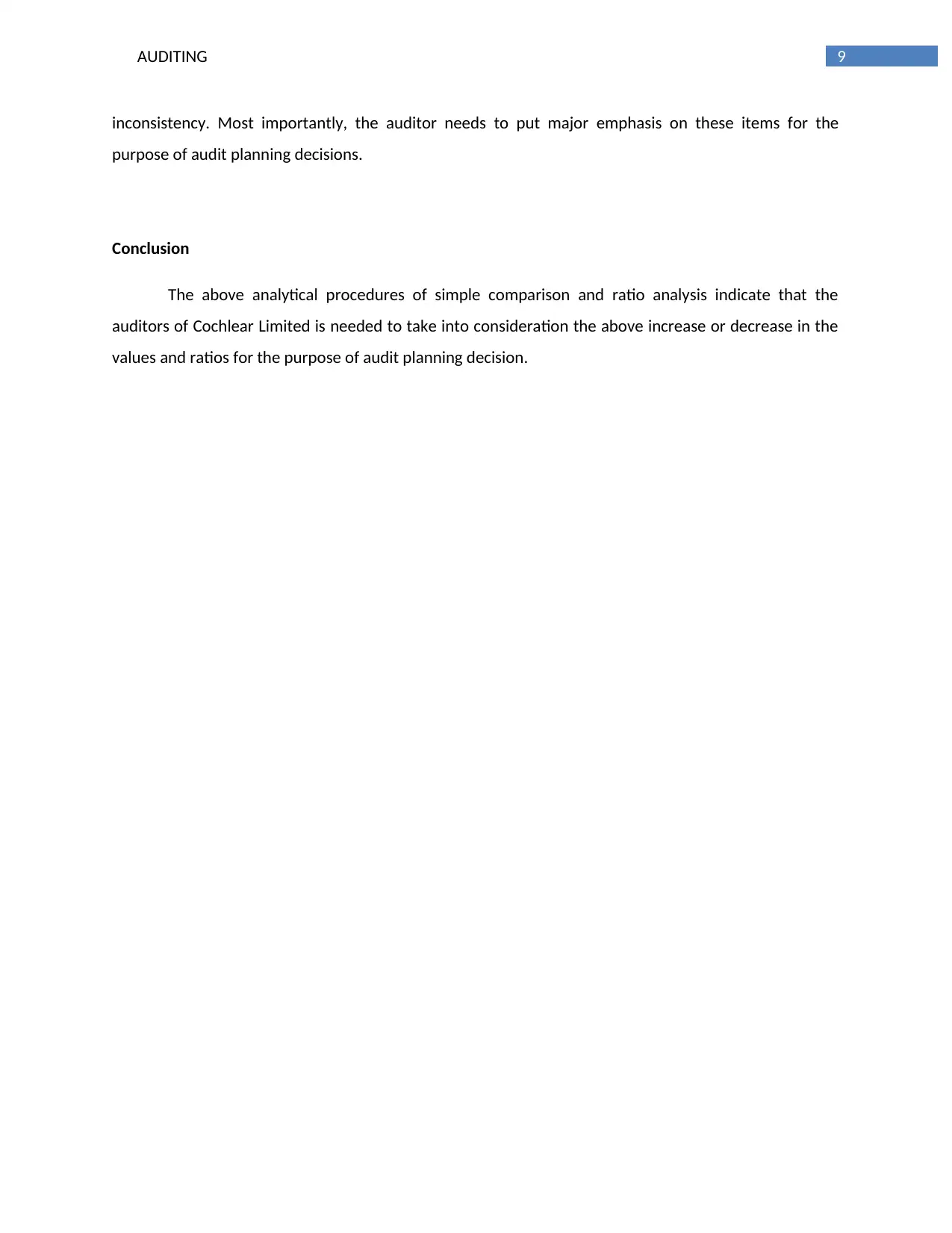
9AUDITING
inconsistency. Most importantly, the auditor needs to put major emphasis on these items for the
purpose of audit planning decisions.
Conclusion
The above analytical procedures of simple comparison and ratio analysis indicate that the
auditors of Cochlear Limited is needed to take into consideration the above increase or decrease in the
values and ratios for the purpose of audit planning decision.
inconsistency. Most importantly, the auditor needs to put major emphasis on these items for the
purpose of audit planning decisions.
Conclusion
The above analytical procedures of simple comparison and ratio analysis indicate that the
auditors of Cochlear Limited is needed to take into consideration the above increase or decrease in the
values and ratios for the purpose of audit planning decision.
Secure Best Marks with AI Grader
Need help grading? Try our AI Grader for instant feedback on your assignments.
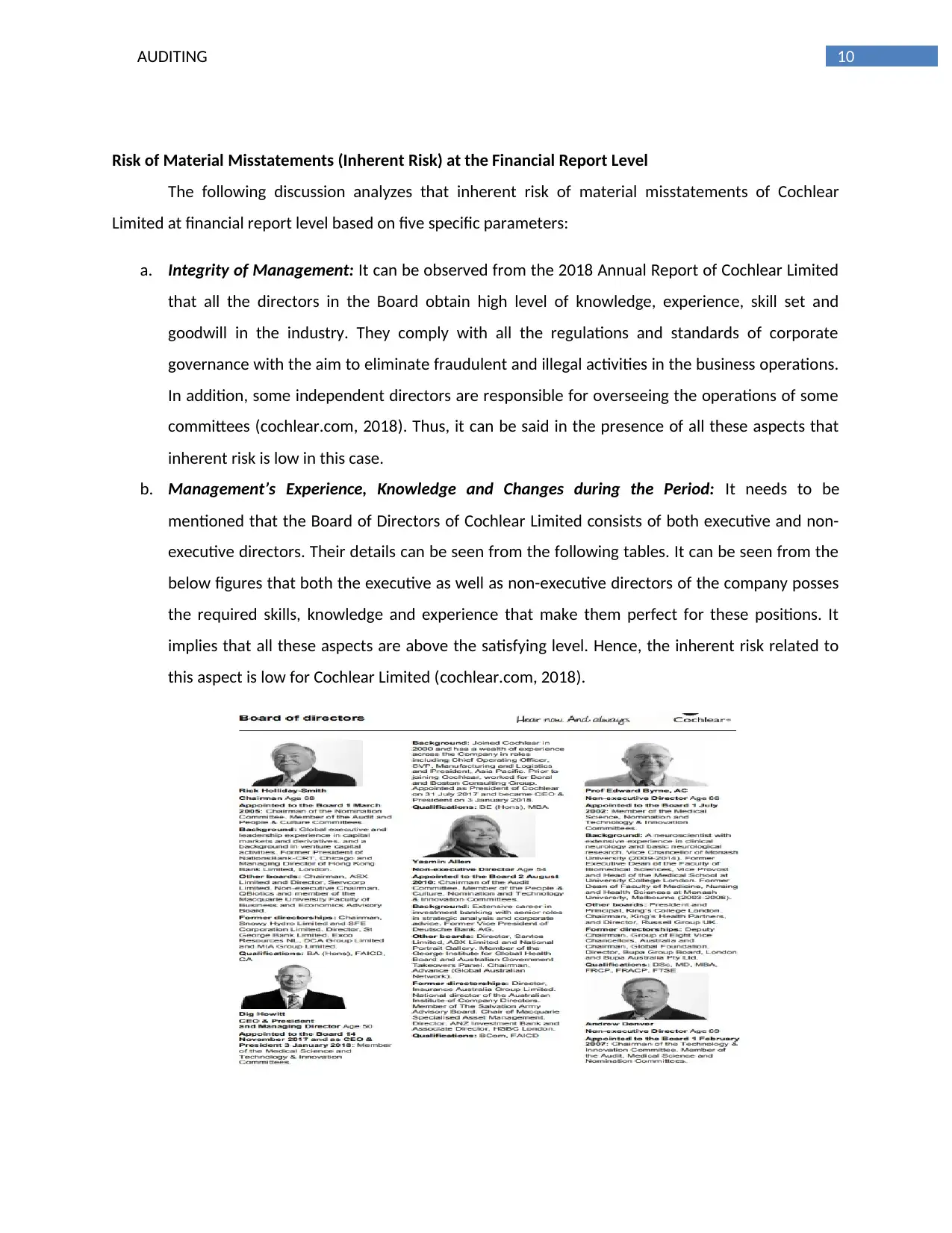
10AUDITING
Risk of Material Misstatements (Inherent Risk) at the Financial Report Level
The following discussion analyzes that inherent risk of material misstatements of Cochlear
Limited at financial report level based on five specific parameters:
a. Integrity of Management: It can be observed from the 2018 Annual Report of Cochlear Limited
that all the directors in the Board obtain high level of knowledge, experience, skill set and
goodwill in the industry. They comply with all the regulations and standards of corporate
governance with the aim to eliminate fraudulent and illegal activities in the business operations.
In addition, some independent directors are responsible for overseeing the operations of some
committees (cochlear.com, 2018). Thus, it can be said in the presence of all these aspects that
inherent risk is low in this case.
b. Management’s Experience, Knowledge and Changes during the Period: It needs to be
mentioned that the Board of Directors of Cochlear Limited consists of both executive and non-
executive directors. Their details can be seen from the following tables. It can be seen from the
below figures that both the executive as well as non-executive directors of the company posses
the required skills, knowledge and experience that make them perfect for these positions. It
implies that all these aspects are above the satisfying level. Hence, the inherent risk related to
this aspect is low for Cochlear Limited (cochlear.com, 2018).
Risk of Material Misstatements (Inherent Risk) at the Financial Report Level
The following discussion analyzes that inherent risk of material misstatements of Cochlear
Limited at financial report level based on five specific parameters:
a. Integrity of Management: It can be observed from the 2018 Annual Report of Cochlear Limited
that all the directors in the Board obtain high level of knowledge, experience, skill set and
goodwill in the industry. They comply with all the regulations and standards of corporate
governance with the aim to eliminate fraudulent and illegal activities in the business operations.
In addition, some independent directors are responsible for overseeing the operations of some
committees (cochlear.com, 2018). Thus, it can be said in the presence of all these aspects that
inherent risk is low in this case.
b. Management’s Experience, Knowledge and Changes during the Period: It needs to be
mentioned that the Board of Directors of Cochlear Limited consists of both executive and non-
executive directors. Their details can be seen from the following tables. It can be seen from the
below figures that both the executive as well as non-executive directors of the company posses
the required skills, knowledge and experience that make them perfect for these positions. It
implies that all these aspects are above the satisfying level. Hence, the inherent risk related to
this aspect is low for Cochlear Limited (cochlear.com, 2018).
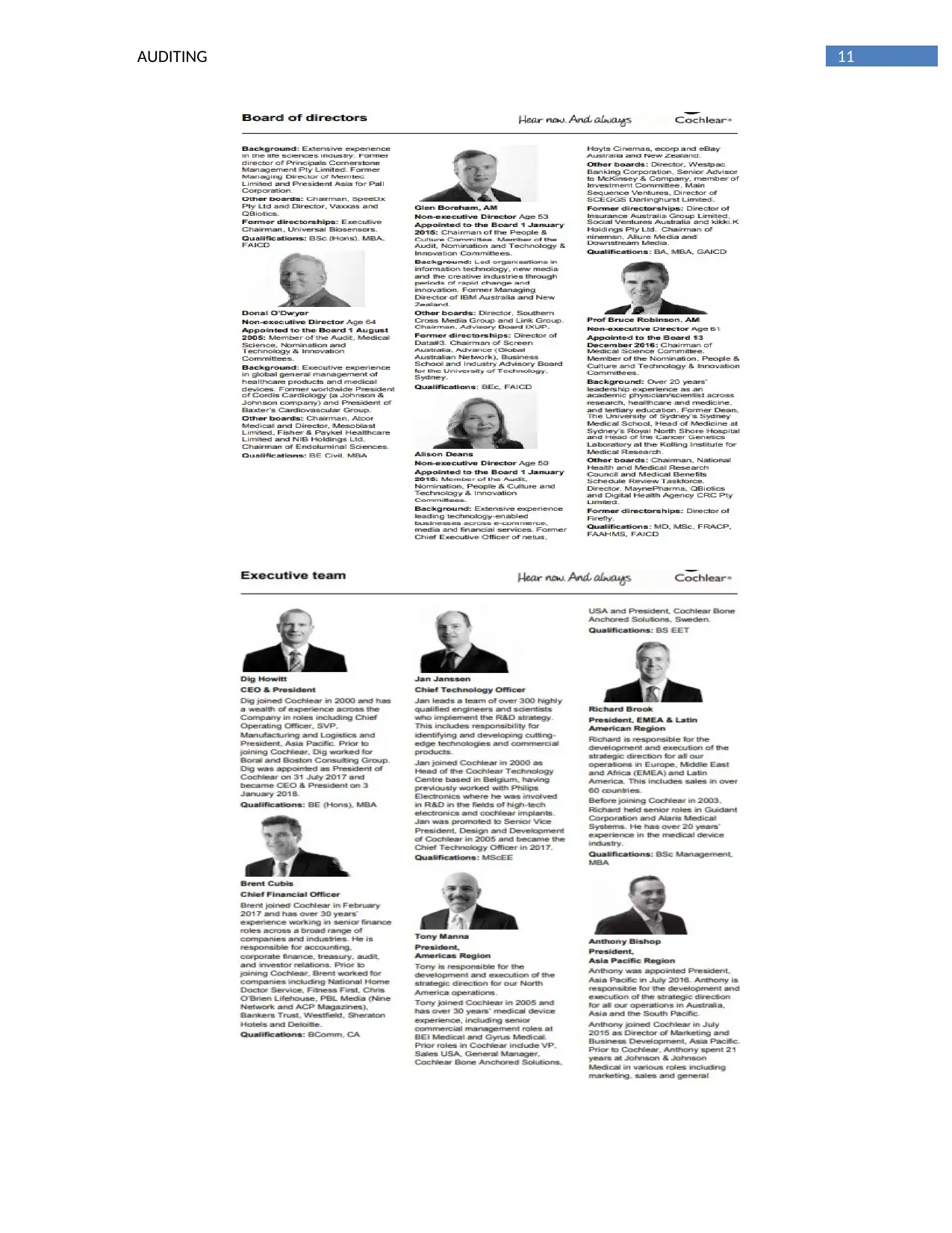
11AUDITING
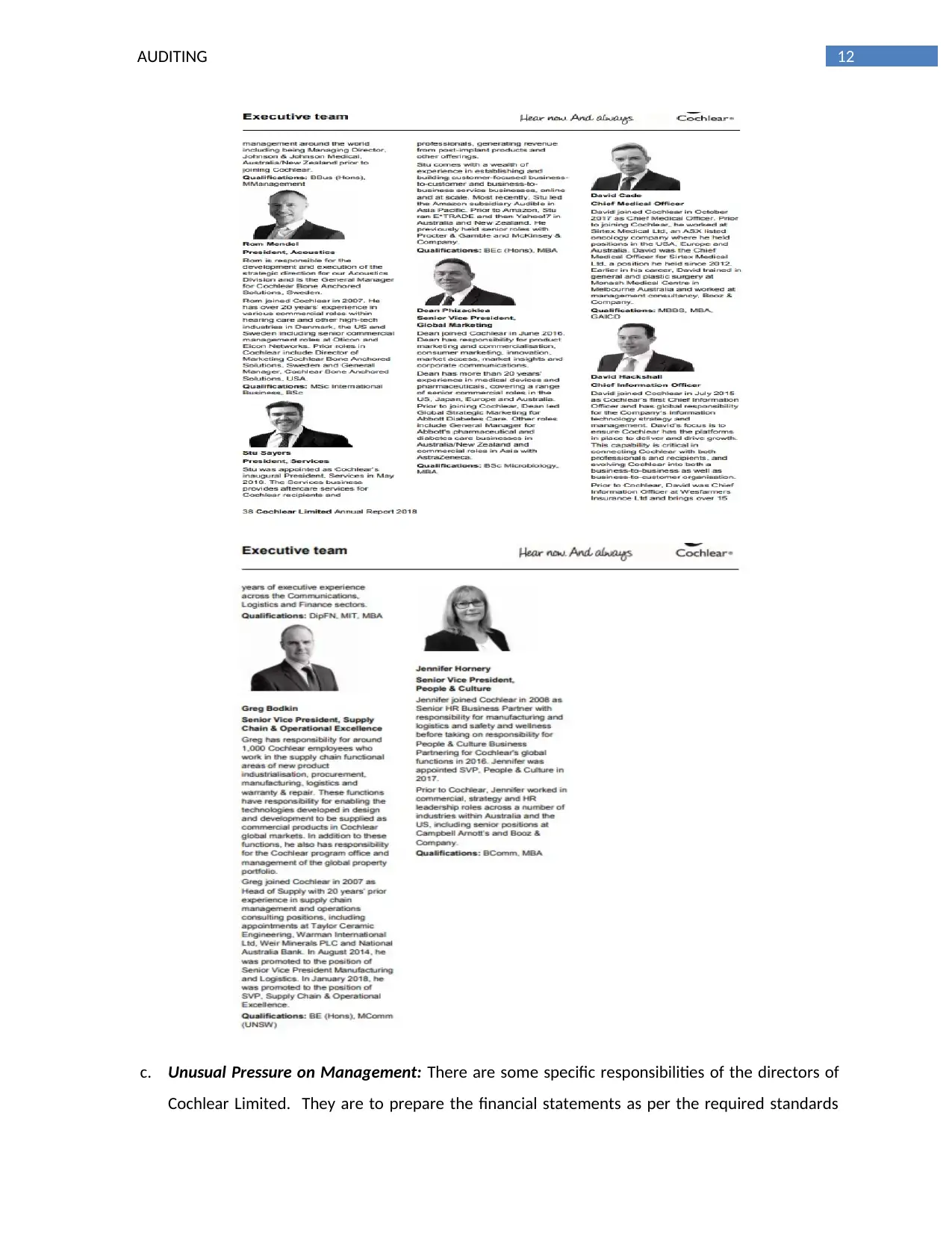
12AUDITING
c. Unusual Pressure on Management: There are some specific responsibilities of the directors of
Cochlear Limited. They are to prepare the financial statements as per the required standards
c. Unusual Pressure on Management: There are some specific responsibilities of the directors of
Cochlear Limited. They are to prepare the financial statements as per the required standards
Paraphrase This Document
Need a fresh take? Get an instant paraphrase of this document with our AI Paraphraser
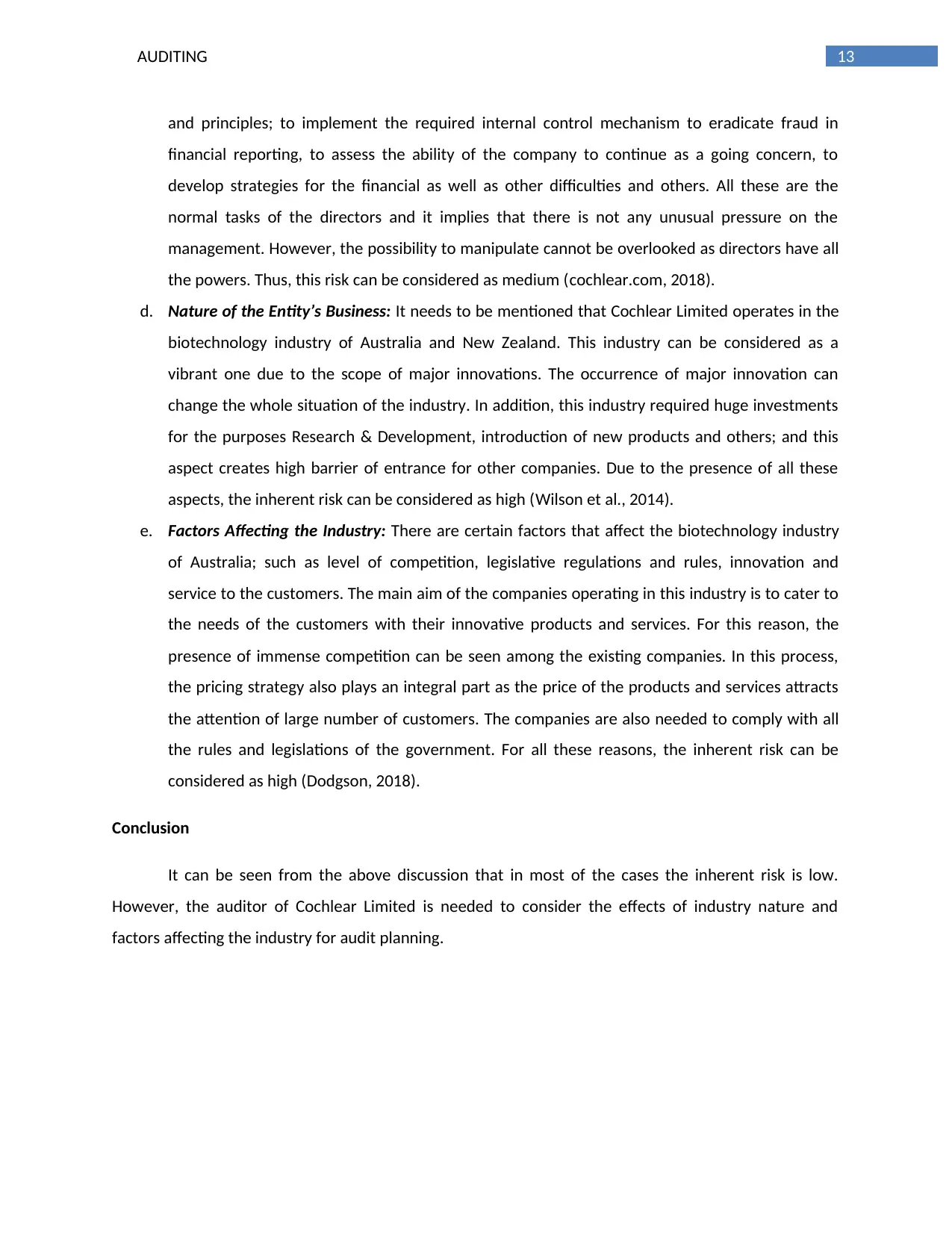
13AUDITING
and principles; to implement the required internal control mechanism to eradicate fraud in
financial reporting, to assess the ability of the company to continue as a going concern, to
develop strategies for the financial as well as other difficulties and others. All these are the
normal tasks of the directors and it implies that there is not any unusual pressure on the
management. However, the possibility to manipulate cannot be overlooked as directors have all
the powers. Thus, this risk can be considered as medium (cochlear.com, 2018).
d. Nature of the Entity’s Business: It needs to be mentioned that Cochlear Limited operates in the
biotechnology industry of Australia and New Zealand. This industry can be considered as a
vibrant one due to the scope of major innovations. The occurrence of major innovation can
change the whole situation of the industry. In addition, this industry required huge investments
for the purposes Research & Development, introduction of new products and others; and this
aspect creates high barrier of entrance for other companies. Due to the presence of all these
aspects, the inherent risk can be considered as high (Wilson et al., 2014).
e. Factors Affecting the Industry: There are certain factors that affect the biotechnology industry
of Australia; such as level of competition, legislative regulations and rules, innovation and
service to the customers. The main aim of the companies operating in this industry is to cater to
the needs of the customers with their innovative products and services. For this reason, the
presence of immense competition can be seen among the existing companies. In this process,
the pricing strategy also plays an integral part as the price of the products and services attracts
the attention of large number of customers. The companies are also needed to comply with all
the rules and legislations of the government. For all these reasons, the inherent risk can be
considered as high (Dodgson, 2018).
Conclusion
It can be seen from the above discussion that in most of the cases the inherent risk is low.
However, the auditor of Cochlear Limited is needed to consider the effects of industry nature and
factors affecting the industry for audit planning.
and principles; to implement the required internal control mechanism to eradicate fraud in
financial reporting, to assess the ability of the company to continue as a going concern, to
develop strategies for the financial as well as other difficulties and others. All these are the
normal tasks of the directors and it implies that there is not any unusual pressure on the
management. However, the possibility to manipulate cannot be overlooked as directors have all
the powers. Thus, this risk can be considered as medium (cochlear.com, 2018).
d. Nature of the Entity’s Business: It needs to be mentioned that Cochlear Limited operates in the
biotechnology industry of Australia and New Zealand. This industry can be considered as a
vibrant one due to the scope of major innovations. The occurrence of major innovation can
change the whole situation of the industry. In addition, this industry required huge investments
for the purposes Research & Development, introduction of new products and others; and this
aspect creates high barrier of entrance for other companies. Due to the presence of all these
aspects, the inherent risk can be considered as high (Wilson et al., 2014).
e. Factors Affecting the Industry: There are certain factors that affect the biotechnology industry
of Australia; such as level of competition, legislative regulations and rules, innovation and
service to the customers. The main aim of the companies operating in this industry is to cater to
the needs of the customers with their innovative products and services. For this reason, the
presence of immense competition can be seen among the existing companies. In this process,
the pricing strategy also plays an integral part as the price of the products and services attracts
the attention of large number of customers. The companies are also needed to comply with all
the rules and legislations of the government. For all these reasons, the inherent risk can be
considered as high (Dodgson, 2018).
Conclusion
It can be seen from the above discussion that in most of the cases the inherent risk is low.
However, the auditor of Cochlear Limited is needed to consider the effects of industry nature and
factors affecting the industry for audit planning.
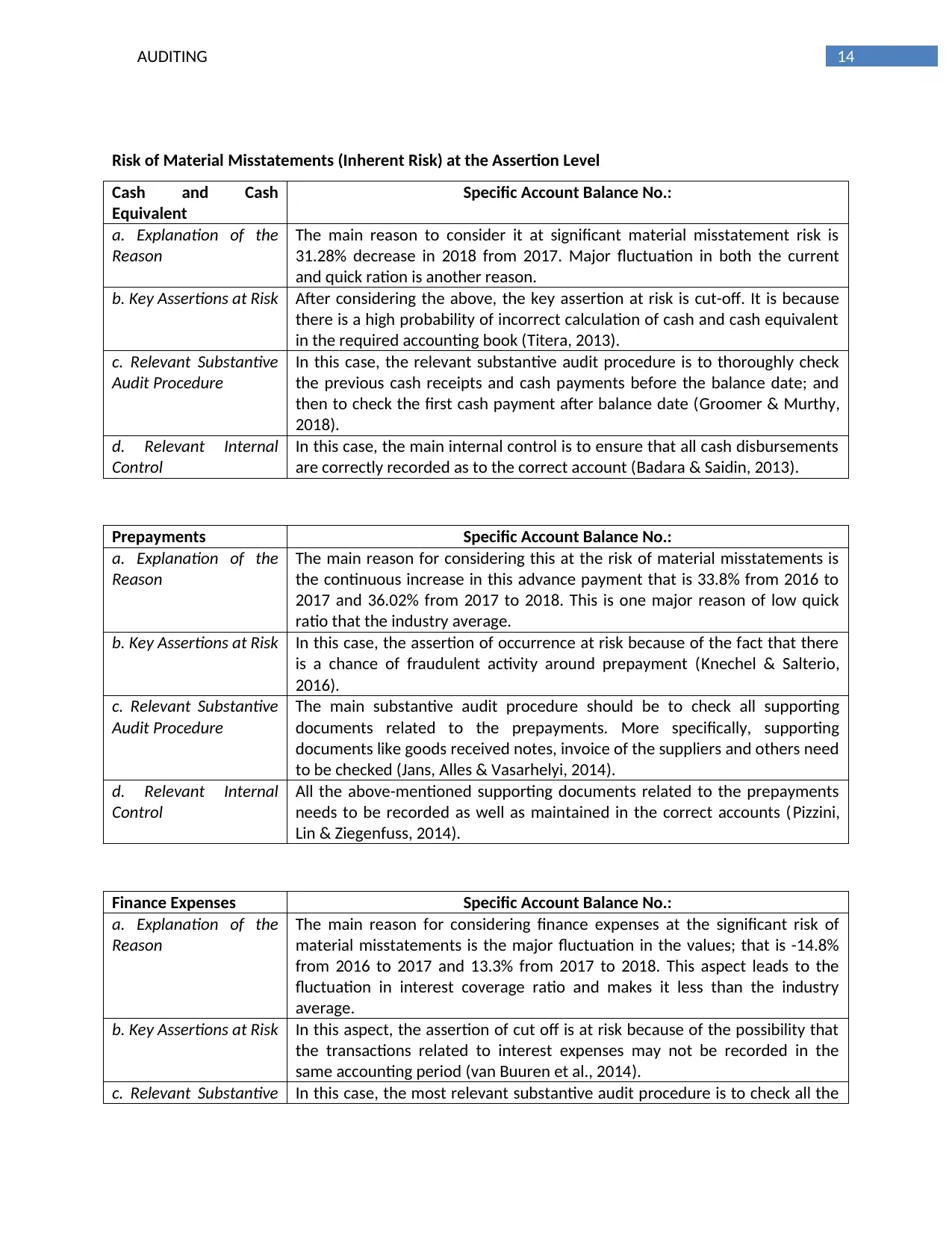
14AUDITING
Risk of Material Misstatements (Inherent Risk) at the Assertion Level
Cash and Cash
Equivalent
Specific Account Balance No.:
a. Explanation of the
Reason
The main reason to consider it at significant material misstatement risk is
31.28% decrease in 2018 from 2017. Major fluctuation in both the current
and quick ration is another reason.
b. Key Assertions at Risk After considering the above, the key assertion at risk is cut-off. It is because
there is a high probability of incorrect calculation of cash and cash equivalent
in the required accounting book (Titera, 2013).
c. Relevant Substantive
Audit Procedure
In this case, the relevant substantive audit procedure is to thoroughly check
the previous cash receipts and cash payments before the balance date; and
then to check the first cash payment after balance date (Groomer & Murthy,
2018).
d. Relevant Internal
Control
In this case, the main internal control is to ensure that all cash disbursements
are correctly recorded as to the correct account (Badara & Saidin, 2013).
Prepayments Specific Account Balance No.:
a. Explanation of the
Reason
The main reason for considering this at the risk of material misstatements is
the continuous increase in this advance payment that is 33.8% from 2016 to
2017 and 36.02% from 2017 to 2018. This is one major reason of low quick
ratio that the industry average.
b. Key Assertions at Risk In this case, the assertion of occurrence at risk because of the fact that there
is a chance of fraudulent activity around prepayment (Knechel & Salterio,
2016).
c. Relevant Substantive
Audit Procedure
The main substantive audit procedure should be to check all supporting
documents related to the prepayments. More specifically, supporting
documents like goods received notes, invoice of the suppliers and others need
to be checked (Jans, Alles & Vasarhelyi, 2014).
d. Relevant Internal
Control
All the above-mentioned supporting documents related to the prepayments
needs to be recorded as well as maintained in the correct accounts (Pizzini,
Lin & Ziegenfuss, 2014).
Finance Expenses Specific Account Balance No.:
a. Explanation of the
Reason
The main reason for considering finance expenses at the significant risk of
material misstatements is the major fluctuation in the values; that is -14.8%
from 2016 to 2017 and 13.3% from 2017 to 2018. This aspect leads to the
fluctuation in interest coverage ratio and makes it less than the industry
average.
b. Key Assertions at Risk In this aspect, the assertion of cut off is at risk because of the possibility that
the transactions related to interest expenses may not be recorded in the
same accounting period (van Buuren et al., 2014).
c. Relevant Substantive In this case, the most relevant substantive audit procedure is to check all the
Risk of Material Misstatements (Inherent Risk) at the Assertion Level
Cash and Cash
Equivalent
Specific Account Balance No.:
a. Explanation of the
Reason
The main reason to consider it at significant material misstatement risk is
31.28% decrease in 2018 from 2017. Major fluctuation in both the current
and quick ration is another reason.
b. Key Assertions at Risk After considering the above, the key assertion at risk is cut-off. It is because
there is a high probability of incorrect calculation of cash and cash equivalent
in the required accounting book (Titera, 2013).
c. Relevant Substantive
Audit Procedure
In this case, the relevant substantive audit procedure is to thoroughly check
the previous cash receipts and cash payments before the balance date; and
then to check the first cash payment after balance date (Groomer & Murthy,
2018).
d. Relevant Internal
Control
In this case, the main internal control is to ensure that all cash disbursements
are correctly recorded as to the correct account (Badara & Saidin, 2013).
Prepayments Specific Account Balance No.:
a. Explanation of the
Reason
The main reason for considering this at the risk of material misstatements is
the continuous increase in this advance payment that is 33.8% from 2016 to
2017 and 36.02% from 2017 to 2018. This is one major reason of low quick
ratio that the industry average.
b. Key Assertions at Risk In this case, the assertion of occurrence at risk because of the fact that there
is a chance of fraudulent activity around prepayment (Knechel & Salterio,
2016).
c. Relevant Substantive
Audit Procedure
The main substantive audit procedure should be to check all supporting
documents related to the prepayments. More specifically, supporting
documents like goods received notes, invoice of the suppliers and others need
to be checked (Jans, Alles & Vasarhelyi, 2014).
d. Relevant Internal
Control
All the above-mentioned supporting documents related to the prepayments
needs to be recorded as well as maintained in the correct accounts (Pizzini,
Lin & Ziegenfuss, 2014).
Finance Expenses Specific Account Balance No.:
a. Explanation of the
Reason
The main reason for considering finance expenses at the significant risk of
material misstatements is the major fluctuation in the values; that is -14.8%
from 2016 to 2017 and 13.3% from 2017 to 2018. This aspect leads to the
fluctuation in interest coverage ratio and makes it less than the industry
average.
b. Key Assertions at Risk In this aspect, the assertion of cut off is at risk because of the possibility that
the transactions related to interest expenses may not be recorded in the
same accounting period (van Buuren et al., 2014).
c. Relevant Substantive In this case, the most relevant substantive audit procedure is to check all the
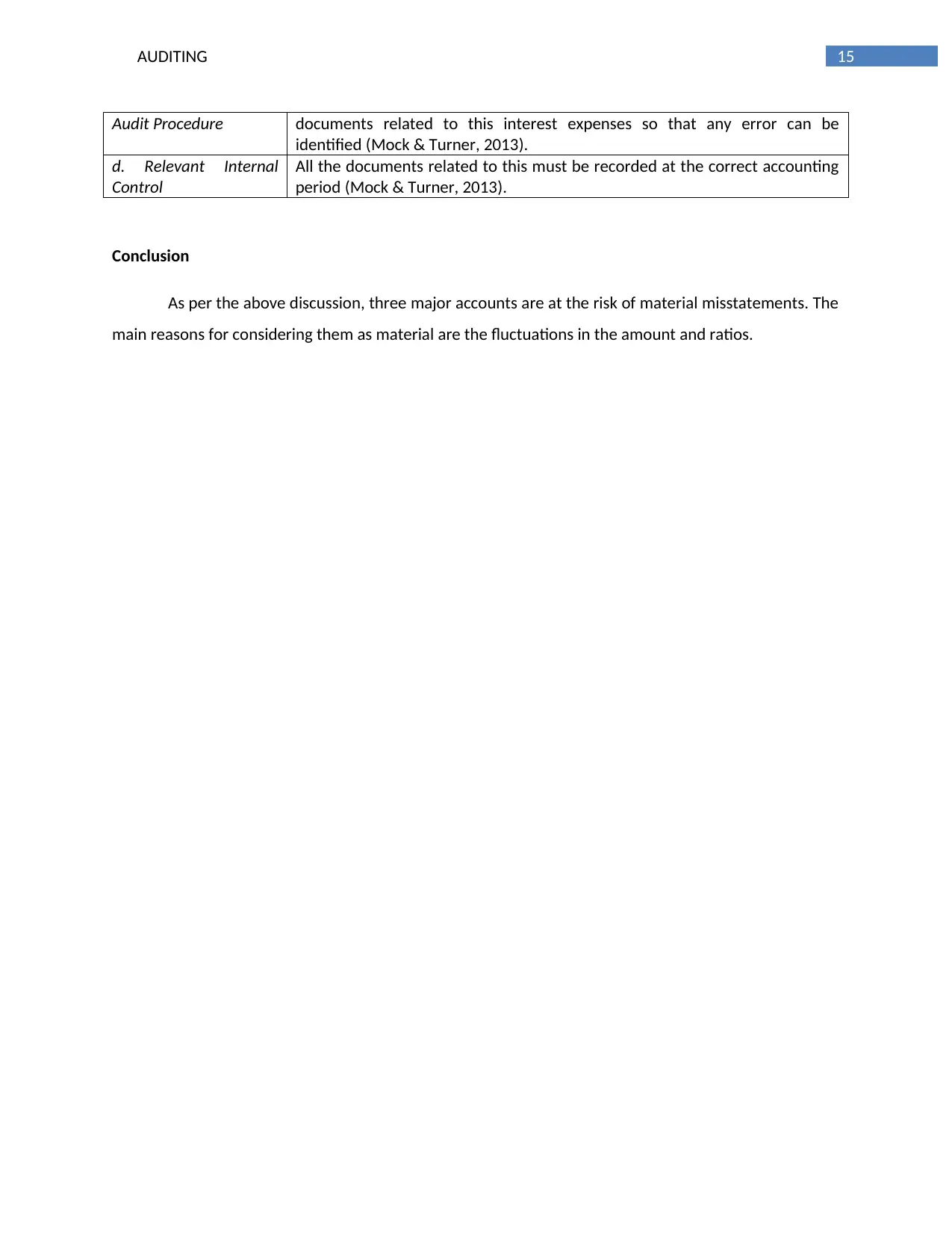
15AUDITING
Audit Procedure documents related to this interest expenses so that any error can be
identified (Mock & Turner, 2013).
d. Relevant Internal
Control
All the documents related to this must be recorded at the correct accounting
period (Mock & Turner, 2013).
Conclusion
As per the above discussion, three major accounts are at the risk of material misstatements. The
main reasons for considering them as material are the fluctuations in the amount and ratios.
Audit Procedure documents related to this interest expenses so that any error can be
identified (Mock & Turner, 2013).
d. Relevant Internal
Control
All the documents related to this must be recorded at the correct accounting
period (Mock & Turner, 2013).
Conclusion
As per the above discussion, three major accounts are at the risk of material misstatements. The
main reasons for considering them as material are the fluctuations in the amount and ratios.
Secure Best Marks with AI Grader
Need help grading? Try our AI Grader for instant feedback on your assignments.
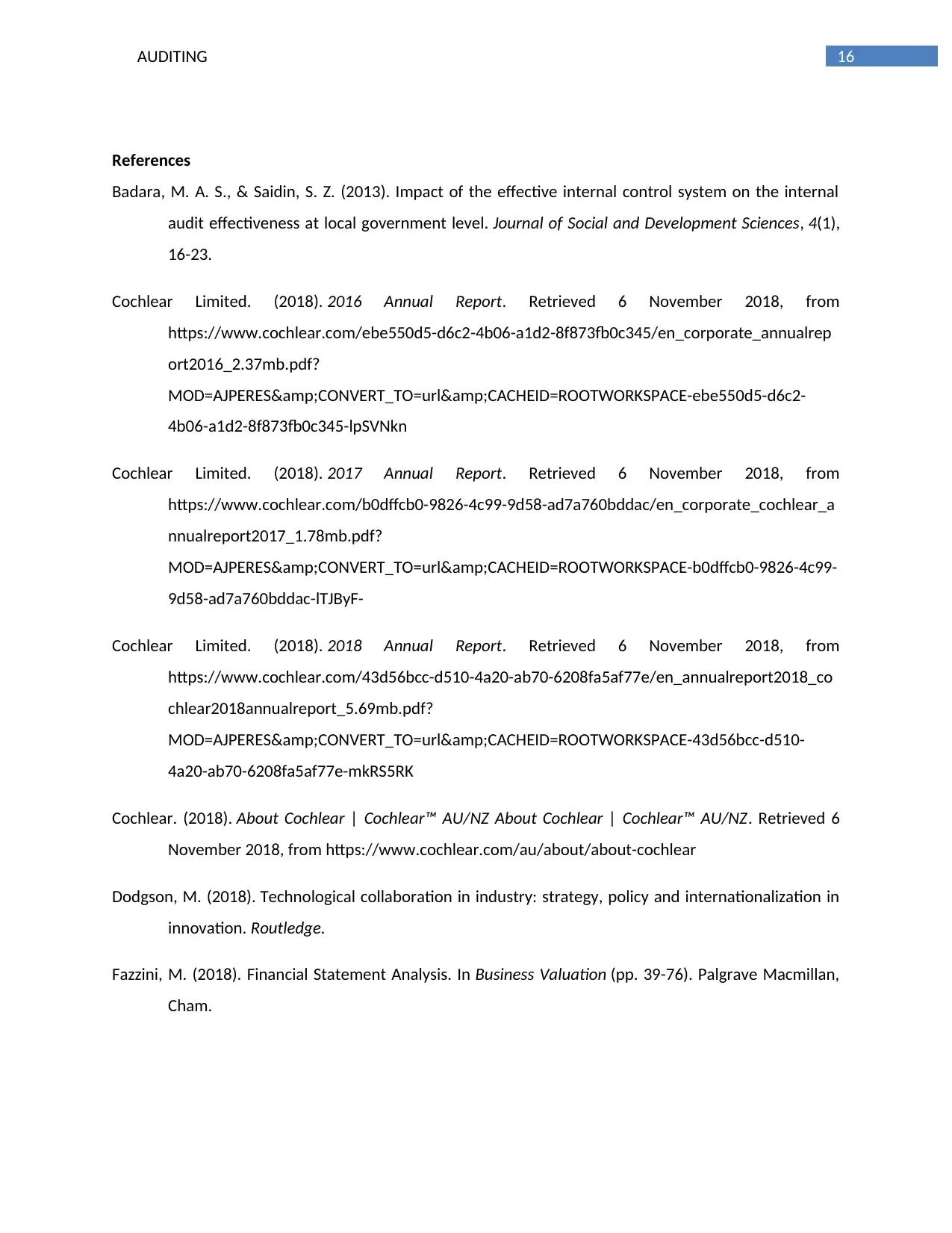
16AUDITING
References
Badara, M. A. S., & Saidin, S. Z. (2013). Impact of the effective internal control system on the internal
audit effectiveness at local government level. Journal of Social and Development Sciences, 4(1),
16-23.
Cochlear Limited. (2018). 2016 Annual Report. Retrieved 6 November 2018, from
https://www.cochlear.com/ebe550d5-d6c2-4b06-a1d2-8f873fb0c345/en_corporate_annualrep
ort2016_2.37mb.pdf?
MOD=AJPERES&CONVERT_TO=url&CACHEID=ROOTWORKSPACE-ebe550d5-d6c2-
4b06-a1d2-8f873fb0c345-lpSVNkn
Cochlear Limited. (2018). 2017 Annual Report. Retrieved 6 November 2018, from
https://www.cochlear.com/b0dffcb0-9826-4c99-9d58-ad7a760bddac/en_corporate_cochlear_a
nnualreport2017_1.78mb.pdf?
MOD=AJPERES&CONVERT_TO=url&CACHEID=ROOTWORKSPACE-b0dffcb0-9826-4c99-
9d58-ad7a760bddac-lTJByF-
Cochlear Limited. (2018). 2018 Annual Report. Retrieved 6 November 2018, from
https://www.cochlear.com/43d56bcc-d510-4a20-ab70-6208fa5af77e/en_annualreport2018_co
chlear2018annualreport_5.69mb.pdf?
MOD=AJPERES&CONVERT_TO=url&CACHEID=ROOTWORKSPACE-43d56bcc-d510-
4a20-ab70-6208fa5af77e-mkRS5RK
Cochlear. (2018). About Cochlear | Cochlear™ AU/NZ About Cochlear | Cochlear™ AU/NZ. Retrieved 6
November 2018, from https://www.cochlear.com/au/about/about-cochlear
Dodgson, M. (2018). Technological collaboration in industry: strategy, policy and internationalization in
innovation. Routledge.
Fazzini, M. (2018). Financial Statement Analysis. In Business Valuation (pp. 39-76). Palgrave Macmillan,
Cham.
References
Badara, M. A. S., & Saidin, S. Z. (2013). Impact of the effective internal control system on the internal
audit effectiveness at local government level. Journal of Social and Development Sciences, 4(1),
16-23.
Cochlear Limited. (2018). 2016 Annual Report. Retrieved 6 November 2018, from
https://www.cochlear.com/ebe550d5-d6c2-4b06-a1d2-8f873fb0c345/en_corporate_annualrep
ort2016_2.37mb.pdf?
MOD=AJPERES&CONVERT_TO=url&CACHEID=ROOTWORKSPACE-ebe550d5-d6c2-
4b06-a1d2-8f873fb0c345-lpSVNkn
Cochlear Limited. (2018). 2017 Annual Report. Retrieved 6 November 2018, from
https://www.cochlear.com/b0dffcb0-9826-4c99-9d58-ad7a760bddac/en_corporate_cochlear_a
nnualreport2017_1.78mb.pdf?
MOD=AJPERES&CONVERT_TO=url&CACHEID=ROOTWORKSPACE-b0dffcb0-9826-4c99-
9d58-ad7a760bddac-lTJByF-
Cochlear Limited. (2018). 2018 Annual Report. Retrieved 6 November 2018, from
https://www.cochlear.com/43d56bcc-d510-4a20-ab70-6208fa5af77e/en_annualreport2018_co
chlear2018annualreport_5.69mb.pdf?
MOD=AJPERES&CONVERT_TO=url&CACHEID=ROOTWORKSPACE-43d56bcc-d510-
4a20-ab70-6208fa5af77e-mkRS5RK
Cochlear. (2018). About Cochlear | Cochlear™ AU/NZ About Cochlear | Cochlear™ AU/NZ. Retrieved 6
November 2018, from https://www.cochlear.com/au/about/about-cochlear
Dodgson, M. (2018). Technological collaboration in industry: strategy, policy and internationalization in
innovation. Routledge.
Fazzini, M. (2018). Financial Statement Analysis. In Business Valuation (pp. 39-76). Palgrave Macmillan,
Cham.
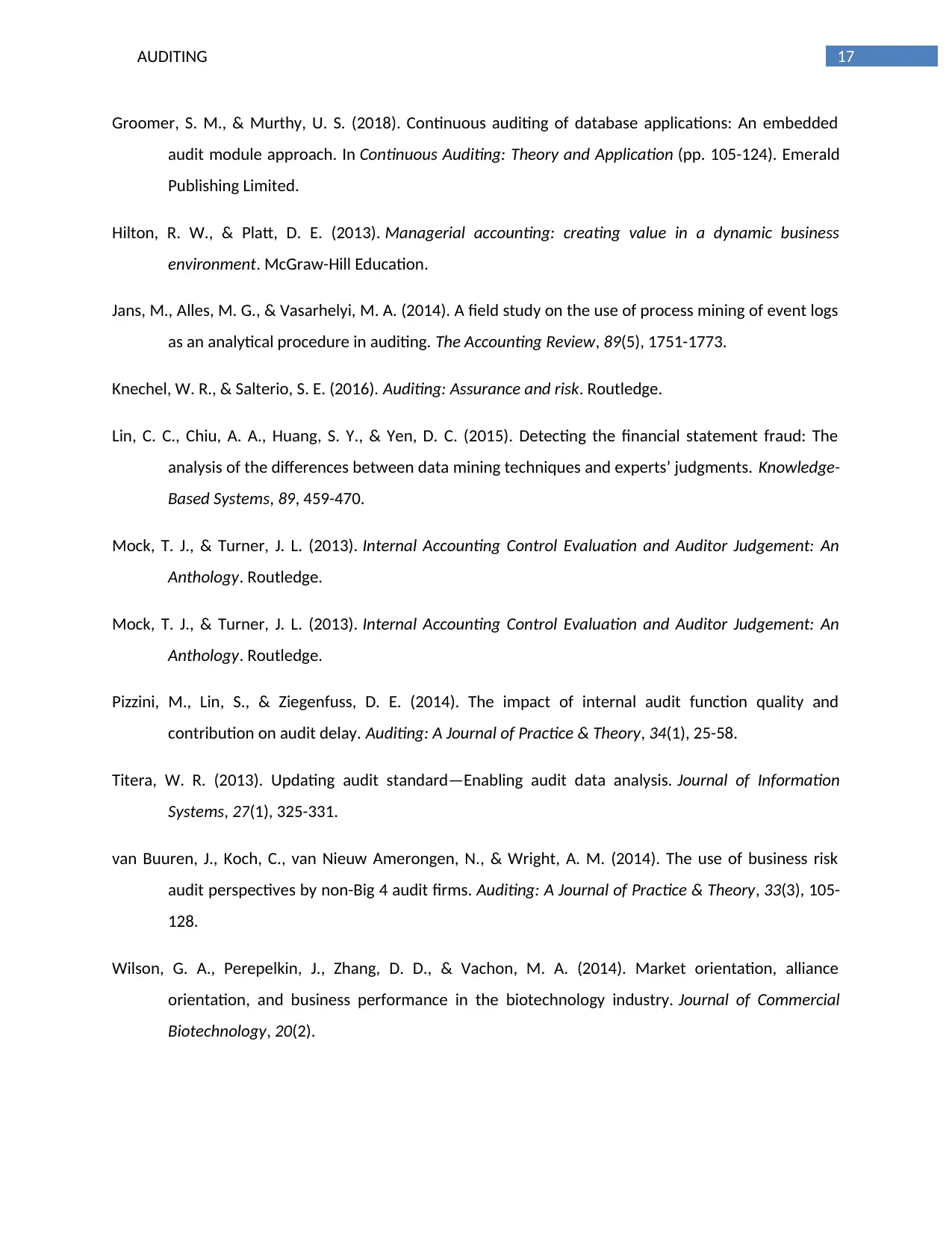
17AUDITING
Groomer, S. M., & Murthy, U. S. (2018). Continuous auditing of database applications: An embedded
audit module approach. In Continuous Auditing: Theory and Application (pp. 105-124). Emerald
Publishing Limited.
Hilton, R. W., & Platt, D. E. (2013). Managerial accounting: creating value in a dynamic business
environment. McGraw-Hill Education.
Jans, M., Alles, M. G., & Vasarhelyi, M. A. (2014). A field study on the use of process mining of event logs
as an analytical procedure in auditing. The Accounting Review, 89(5), 1751-1773.
Knechel, W. R., & Salterio, S. E. (2016). Auditing: Assurance and risk. Routledge.
Lin, C. C., Chiu, A. A., Huang, S. Y., & Yen, D. C. (2015). Detecting the financial statement fraud: The
analysis of the differences between data mining techniques and experts’ judgments. Knowledge-
Based Systems, 89, 459-470.
Mock, T. J., & Turner, J. L. (2013). Internal Accounting Control Evaluation and Auditor Judgement: An
Anthology. Routledge.
Mock, T. J., & Turner, J. L. (2013). Internal Accounting Control Evaluation and Auditor Judgement: An
Anthology. Routledge.
Pizzini, M., Lin, S., & Ziegenfuss, D. E. (2014). The impact of internal audit function quality and
contribution on audit delay. Auditing: A Journal of Practice & Theory, 34(1), 25-58.
Titera, W. R. (2013). Updating audit standard—Enabling audit data analysis. Journal of Information
Systems, 27(1), 325-331.
van Buuren, J., Koch, C., van Nieuw Amerongen, N., & Wright, A. M. (2014). The use of business risk
audit perspectives by non-Big 4 audit firms. Auditing: A Journal of Practice & Theory, 33(3), 105-
128.
Wilson, G. A., Perepelkin, J., Zhang, D. D., & Vachon, M. A. (2014). Market orientation, alliance
orientation, and business performance in the biotechnology industry. Journal of Commercial
Biotechnology, 20(2).
Groomer, S. M., & Murthy, U. S. (2018). Continuous auditing of database applications: An embedded
audit module approach. In Continuous Auditing: Theory and Application (pp. 105-124). Emerald
Publishing Limited.
Hilton, R. W., & Platt, D. E. (2013). Managerial accounting: creating value in a dynamic business
environment. McGraw-Hill Education.
Jans, M., Alles, M. G., & Vasarhelyi, M. A. (2014). A field study on the use of process mining of event logs
as an analytical procedure in auditing. The Accounting Review, 89(5), 1751-1773.
Knechel, W. R., & Salterio, S. E. (2016). Auditing: Assurance and risk. Routledge.
Lin, C. C., Chiu, A. A., Huang, S. Y., & Yen, D. C. (2015). Detecting the financial statement fraud: The
analysis of the differences between data mining techniques and experts’ judgments. Knowledge-
Based Systems, 89, 459-470.
Mock, T. J., & Turner, J. L. (2013). Internal Accounting Control Evaluation and Auditor Judgement: An
Anthology. Routledge.
Mock, T. J., & Turner, J. L. (2013). Internal Accounting Control Evaluation and Auditor Judgement: An
Anthology. Routledge.
Pizzini, M., Lin, S., & Ziegenfuss, D. E. (2014). The impact of internal audit function quality and
contribution on audit delay. Auditing: A Journal of Practice & Theory, 34(1), 25-58.
Titera, W. R. (2013). Updating audit standard—Enabling audit data analysis. Journal of Information
Systems, 27(1), 325-331.
van Buuren, J., Koch, C., van Nieuw Amerongen, N., & Wright, A. M. (2014). The use of business risk
audit perspectives by non-Big 4 audit firms. Auditing: A Journal of Practice & Theory, 33(3), 105-
128.
Wilson, G. A., Perepelkin, J., Zhang, D. D., & Vachon, M. A. (2014). Market orientation, alliance
orientation, and business performance in the biotechnology industry. Journal of Commercial
Biotechnology, 20(2).
1 out of 18
Related Documents
Your All-in-One AI-Powered Toolkit for Academic Success.
+13062052269
info@desklib.com
Available 24*7 on WhatsApp / Email
![[object Object]](/_next/static/media/star-bottom.7253800d.svg)
Unlock your academic potential
© 2024 | Zucol Services PVT LTD | All rights reserved.



